![]()
![]()
![]()
Use LEFT and RIGHT arrow keys to navigate between flashcards;
Use UP and DOWN arrow keys to flip the card;
H to show hint;
A reads text to speech;
423 Cards in this Set
- Front
- Back
|
Week 05 How Quantifiers Modify Categories |
A |
|
|
Week 05 |
All dobermans are dogs. |
|
|
Week 05 How Quantifiers Modify Categories |
The Fs outside of G are shaded out |
|
|
Week 05 How Quantifiers Modify Categories
How does a Venn diagram show negation |
The two areas that are the negation of each other, one has an "X" in the same spot where the other one is "shaded' |
|
|
Week 05 Immediate Categorical Inference |
It is an inference with just 1 premise, in which both the premise and the conclusion are of the form A, E, I, or O |
|
|
Week 05 Immediate Categorical Inference |
This type of Immediate Categorical Inference is a Conversion |
|
|
Week 05 Immediate Categorical Inference |
E,I,A,O |
|
|
Week 05 Immediate Categorical Inference |
T, subject, predicate |
|
|
Week 05 How Quantifiers Modify Categories
Inconsistent can be interpreted as _________________. Therefore, when looking for the negation of categorical inference, ____________ the Venn Diagram, "shade" or "X" the inference, then _________ or __________ the area accordingly. __________ the diagram. The interpretation is the ___________________. |
the negation, Draw, shade, X, Interpret, inconsistency.
|
|
|
Week 05 Syllogisms |
subject, one, must, "minor premise"
|
|
|
Week 05 Syllogisms
The predicate term of the conclusion is called the ____________ term of the syllogism, and ___________ of the premises must also contain the ___________ term: that premise is the ___________ ______________. |
predicate, one, predicate, "major premise"
|
|
|
Week 05 Syllogisms |
There are three circles because there are three categories. They are F, G, and H. |
|
|
Week 05 Syllogisms
Using the following syllogism, use the a Venn Diagram to show the validity of the argument.
All Duke students are humans. All humans are animals. ------------------------------------------ All Duke students are animals. |
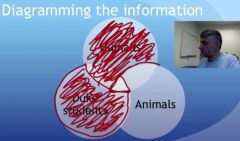
The small triangle in the middle contains all Duke students. This argument is valid. |
|
|
Week 05 Syllogisms
Using the following syllogism, use the a Venn Diagram to show the validity of the argument.
Some Duke students are humans. All humans are animals. ------------------------------------------ Some Duke students are animals. |
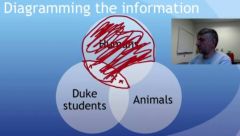
The small triangle in the middle contains some Duke students. This argument is valid. |
|
|
Week 05 Syllogisms
Using the following syllogism, use the a Venn Diagram to show the validity of the argument.
No Duke students are humans. All humans are animals. ------------------------------------------ No Duke students are animals. |
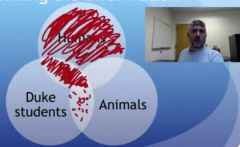
This argument is invalid. The Venn Diagram shows that Duke students could possibly be animals although they are not humans.
For this argument to be valid, the "minor premise" would have to say "Only humans are animals". |
|
|
Week 05 Categories, Individuals, and Language
How could one restate the following to show it as a having categories since it appears to be about an individual and not categories:
Mary owns a Ferrari. |
Some of Mary's possessions are Ferrari cars.
Some Fs are Gs.
Fs - Mary's possessions Gs - Ferrari cars |
|
|
Week 05 Categories, Individuals, and Language
T or F. Not every statement that we make are of the A, E, I or O form but lots and lots of statements that we make are. |
True. |
|
|
Week 05 Categories, Individuals, and Language
An earlier argument about Terry
(1) Terry has a job in which she arrest people. (2) Only police officers can arrest people ------------------------------------------------------------- :. (3) At least one of Terry's jobs is as a policy officer.
Conceptually draw the Venn Diagram for this logic as an example of how normal language can be used when involving individuals to categorize the information to use a Venn Diagram to check validity. |

|
|
|
Week 05 Categories, Individuals, and Language
T or F Venn Diagrams that have been "marked up" and have the same form are considered to have the same type of argument. |
True. |
|
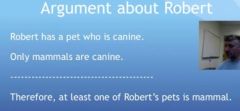
Week 05 Categories, Individuals, and Language
An argument from an earlier lesson where again we can "categorize" to have the argument conform to a Venn Diagram to help determine validity. |
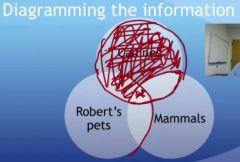
|
|
|
Into which category of A, E, I, or O do the following fall into?
|
Recall the forms
|
|

Week 06 Reasoning from Venn Diagrams or Truth Tables Alone
Would the following be true based on the truth-table, left is premise 1 and 2 are true.
(1) John is riding his bicycle SPooG Jill is walking to the park (2) Jill walking to the park. ----------------------------------------------------------- :.(3) John is riding his bicycle. |
Yes, it would be valid. One can use the truth-table to eliminate the other possibilities by starting with the SPooG column and the three trues. |
|
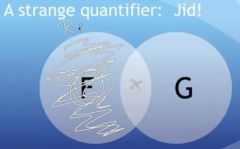
Week 06 Reasoning from Venn Diagrams or Truth Tables
How would one interpret the Venn Diagram, left? |
First, note that F is "shaded" and there is also an "X", an unconventional format for a Venn Diagram.
Nonetheless, it represent there are some Fs (say Ravens for arguments sake) and all of them are Gs (birds). They use the word all to actually say this but they say "All ravens are birds". This is not the same as saying "There are ravens, and they are all birds" which is what the diagram represents. |
|
|
Week 07 What is Induction?
Name some types of inductive arguments |
|
|
|
Week 07 What is Induction?
Define what a valid argument is. |
A argument is valid if, and only if, it is not possible for the premises to be true and the conclusion false. |
|
|
Week 07 What is Induction?
T or F. An argument is good if it serves it purposes or the premises provide a reason for it's conclusion. |
T |
|
|
Week 07 What is Induction?
T or F. An argument can be good and invalid. |
T |
|
|
Week 07 What is Induction?
What are the standards for deductive and inductive arguments? |
Standards for Deductive ---------------------------------- Valid or Invalid
Standards for Inductive ---------------------------------- Strong or Weak |
|
|
Week 07 What is Inductive?
Deductive arguments are __________ when they are _______________ whereas inductive arguments CAN be good if they're _______________. |
bad, invalid, invalid |
|
|
Week 07 What is Inductive?
What does defeasible or non-monotonic mean when considering an argument?
In contrast, what does indefeasible or monotonic mean for deductive arguments? |
It is a measure of degrees of strength.
It means no matter what premises you add to a deductive argument it will still be valid.
However, indefeasible means that information could be added that turns a strong argument to a weak one. |
|
|
Week 07
T or F Many people believe that inductive argument takes us from the particular to the general.
If it is true, why would it not be true. |
T, Inductive generalization is one type of argument but it is not the only kind. |
|
|
Week 07 What is Induction?
Name the five types of arguments that we study in this course? |
|
|
|
Week 07 Generalizations
Generalizations move from ______________ to ideally _________________. |
samples, predicions. |
|
|
Week 07 Generalizations from Samples
Universal:
The first F is G. The second F is G. The rest of the Fs in the sample are G -------------------------------------------------------- :. ________ Fs are G. |
All |
|
|
Week 07 Generalizations from Samples
Partial
The first F is G. The second F is G. The third F is not G. The fourth F is G. --------------------------------- :. _______ of Fs are G |
X%, some |
|
|
Week 07 Generalizations from Samples
When the argument moves from part of the class to the whole class shows that it's ______________. |
inductive |
|
|
Week 07 Generalizations from Samples
If one increase the size of your sample in an inductive argument, that will make it stronger, always. |
False, sometimes. The new sample would have to agree with the previous sample. Otherwise, the argument is weakened. |
|
|
Week 07 Generalizations from Samples
Who said there're lies, there're damn lies, and there's statistics. |
Mark Twain, 1835-1910. He gives credit to Benjamin Disraeli, 1804-1881, for having said it first. |
|
|
Week 07 When are Generalizations Strong?
A premise from a generalization of a sample have to be ________________ and __________________. |
true (not a lie), justified (done right, counting for instance with care and not carelessly) |
|
|
Week 07 When are Generalizations Strong?
What is the fallacy of hasty generalization? |
It is generalization from too small a sample.
For instance, you see one car that is a junker so you conclude all those cars are junkerst |
|
|
Week 07 When are Generalizations Strong?
When does sample size matter? |
When the stakes are high are low (like testing parachutes) or testing something like whether or not apples from a tree float in water. If one apple floats, it would be safe to assume almost all of the rest if not all will float just based on what you already know about the biology of those apples. |
|
|
Week 07 When are Generalizations Strong?
What is the fallacy of biased sampling? |
The data could be biased toward the conclusion you or someone else from whom the sample was taken could be biased. |
|
|
Week 07 When are Generalizations Strong?
Describe the bias sampling case of FDR (183-1945) and Alf Landon (1887-1987) where the Literary Digest did a sample |
In 1936, they concluded 56,44 but it was 62,38. The problem with the sampling is they used phone books to take their sample but poor people and many people did not have phones. Many of these people liked FDR because of the New Deal. |
|
|
Week 07 When are Generalizations Strong?
What does slanting mean? |
The data was manipulated to come up with the desired conclusion. This occurs with a dishonest person conducting the research.
A question could also be worded in such a way that it produces a desired response. |
|
|
Week 07 When are Generalizations Strong?
What are the 4 questions to ask about generalizations? |
|
|
|
Week 07 Applying Generalizations
What are applications of generalizations sometimes called?
What is the problem with this? |
statistical syllogisms. They're not statistics because they may not use math and they're not syllogisms that we use in deductive arguments. |
|
|
Week 07 Applying Generalizations
In the following application of generalization describe the reference class and the predicate
Almost all professors who are teaching are wearing shoes. Walter is a professor who is teaching ------------------------------------------------------- :.Walter is (probably) wearing shoes. |
F, using generally accepted notation, can be substituted for professors, hence
F=the subject in the general premise=reference class
G can be substituted for wearing shoes
G=the predicate in the general premise=attribute class
a, lower case, can be substituted for the person.
X% can be substituted for almost
This is a case of taking the first premise which is a generalization and applying to someone ( or something) specific like Walter
|
|
|
Week 07 Applying Generalizations
What is a complete enumeration type argument? |
Using the entire sample. |
|
|
Week 07 Applying Generalizations
How do we when an application of generalization is strong |
|
|
|
Week 07 Applying Generalizations
The reference class is the reference class that occurs in BOTH premises. Identify the reference class in the following.
Almost all professors who are teaching are wearing shoes. Walter is a professor who is teaching ------------------------------------------------------- :.Walter is (probably) wearing shoes. |
Professors who are teaching |
|
|
Week 07 Applying Generalizations
Identify a conflicting reference class in the following?
Almost all professors who are teaching are wearing shoes. Walter is a professor who is teaching ------------------------------------------------------- :.Walter is (probably) wearing shoes.
If there's a conflicting reference class which one should be used? |
(Online) professors who are teaching. This group wearing shoes could be significantly smaller.
Use the smallest (narrowest) reference class when there is a conflicting reference class. |
|
|
Week 07 Inference to the Best Explanation
What is probably the most common type of inductive argument? |
Inference to the Best Explanation |
|
|
Week 07 Inference to the Best Explanation Almost ___________ detective stories are inference to the best explanation |
all |
|
|
Week 07 Inference to the Best Explanation
What characterizes Inference to the Best Explanation argument?
Would what killed the dinosaurs be this type of argument? |
The conclusion are assumed to be true and the arguments justify using explanation the conclusions.
Yes. |
|
|
Week 07 Inference to the Best Explanation
Think of Inference to the Best Explanation of "____________ something and the explanation is the argument" like "Why did the water hit my head?" Because there's a leak in the roof.
In this type of argument, the __________ explain the _______________. |
Why, premises, conclusion |
|
|
Week 07 Inference to the Best Explanation
Inductive can be _________________ even though they are strong and good. |
defeasible |
|
|
Week 07 Inference to the Best Explanation
Scientist use inference to the _________ explanation to draw conclusions from observations in their experiments. |
best
After scientists perform experiments and get results, they need to determine which hypothesis about what happened in the experiment best explains why they got the results that they got. For example, suppose a scientist adds a chemical to a group of live bacteria and then observes that the bacteria are dead an hour later. The scientist infers that the best explanation of why the bacteria died is that the chemical killed those bacteria. That inference provides some reason to believe that this chemical kills that kind of bacteria. |
|
|
Week 07 Inference to the Best Explanation
One premise in an inference to the best explanation claims that one explanation is better than others. |
The correct answer is "True." |
|
|
Week 07 Inference to the Best Explanation
If two competing explanations are equally good, then we can use an inference to the best explanation to justify belief in one of them. |
The correct answer is "False." |
|
|
Week 07 Inference to the Best Explanation
The conclusion of an inference to the best explanation is supposed to explain an observation in one of the premises.
|
The correct answer is "True." |
|
|
Week 07 Inference to the Best Explanation
Imagine that you offer an explanation of some surprising event, and then someone criticizes your explanation by saying, “Your explanation won’t explain anything other than this particular case.” Which explanatory virtue is this critic claiming that your explanation lacks?
|
Falsifiability Conservativeness Power (or Breadth) Depth Modesty |
|
|
Week 07 Inference to the Best Explanation
Imagine that you offer an explanation of some surprising event, and then someone criticizes your explanation by saying, “Your explanation conflicts with everything we know about biology.” Which explanatory virtue is this critic claiming that your explanation lacks?
|
Falsifiability Conservativeness Power (or Breadth) Depth Modesty |
|
|
Week 07 Inference to the Best Explanation
Imagine that you offer an explanation of some surprising event, and then someone criticizes your explanation by saying, “You don’t have to claim so much in order to explain what happened.” Which explanatory virtue is this critic claiming that your explanation lacks?
|
Falsifiability Conservativeness Power (or Breadth) Depth Modesty |
|
|
Week 07 Inference to the Best Explanation
Imagine that you offer an explanation of some surprising event, and then someone criticizes your explanation by saying, “Your explanation just raises new questions that you also need to answer.” Which explanatory virtue is this critic claiming that your explanation lacks?
|
Falsifiability Conservativeness Power (or Breadth) Depth Modesty
The correct answer is "Depth." |
|
|
Week 07 Inference to the Best Explanation
Imagine that you offer an explanation of some surprising event, and then someone criticizes your explanation by saying, “Your explanation would apply to whatever happened.” Which explanatory virtue is this critic claiming that your explanation lacks?
|
Falsifiability Conservativeness Power (or Breadth) Depth Modesty
The correct answer is "Falsifiability." |
|
|
Week 07 Inference to the Best Explanation
Indicate which explanatory virtue is the main one that is lacking from this explanation: I fished here all day, but I did not catch any fish, because there are no fish anywhere in this river.
Falsifiability Conservativeness Power (or Breadth) Depth Modesty |
Falsifiability Conservativeness Power (or Breadth) Depth Modesty
The correct answer is "Modesty." |
|
|
Week 07 Inference to the Best Explanation
Indicate which explanatory virtue is the main one that is lacking from this explanation: My car won’t start today, because it is mad at me for driving it so much.
Falsifiability Conservativeness Power (or Breadth) Depth Modesty |
Falsifiability Conservativeness Power (or Breadth) Depth Modesty |
|
|
Week 07 Inference to the Best Explanation
Indicate which explanatory virtue is the main one that is lacking from this explanation: Her flowers won’t grow because something is wrong with them.
Falsifiability Conservativeness Power (or Breadth) Depth Modesty |
Falsifiability Conservativeness Power (or Breadth) Depth Modesty |
|
|
Week 07 Inference to the Best Explanation
Imagine that you offer an explanation of some surprising event, and then someone criticizes your explanation by saying, “You don’t have to claim so much in order to explain what happened.” Which explanatory virtue is this critic claiming that your explanation lacks?
Falsifiability Conservativeness Power (or Breadth) Depth Modesty |
Falsifiability Conservativeness Power (or Breadth) Depth Modesty |
|
|
Week 07 Inference to the Best Explanation
Imagine that you offer an explanation of some surprising event, and then someone criticizes your explanation by saying, “Your explanation conflicts with everything we know about biology.” Which explanatory virtue is this critic claiming that your explanation lacks?
Falsifiability Conservativeness Power (or Breadth) Depth Modesty |
Falsifiability Conservativeness Power (or Breadth) Depth Modesty |
|
|
Week 07 Inference to the Best Explanation
Imagine that you offer an explanation of some surprising event, and then someone criticizes your explanation by saying, “You don’t have to claim so much in order to explain what happened.” Which explanatory virtue is this critic claiming that your explanation lacks?
Falsifiability Conservativeness Power (or Breadth) Depth Modesty
|
The correct answer is "Modesty." |
|
|
Week 07 Inference to the Best Explanation
Indicate which explanatory virtue is lacking from this explanation: I lost the race because I just did not happen to run well today.
Falsifiability Conservativeness Power (or Breadth) Depth Modesty
|
Falsifiability Conservativeness Power (or Breadth) Depth Modesty
The correct answer is ”Power (or Breadth).” |
|
|
Week 07 Inference to the Best Explanation
In the situation described in the student video in the lecture, which virtue of explanations would be lacking from the hypothesis that Timmy the Cat knocked the cookies off the counter because he was trying to eat one of them?
|
Falsifiability Power or Breadth Modesty Conservativeness
This new hypothesis ascribes a motive to the cat (“…because he was trying to eat one of them”). It is not necessary to postulate any motive, because cats often knock things over by mistake. (Besides, who can tell what is going on in the mind of a cat?) Thus, this hypothesis claims more than is needed, so it is lacks modesty. |
|
|
Week 07 Arguments from analogy
An argument from analogy is stronger when |
|
|
|
Week 08 Causal Reasoning
Causal events are about one event _____________ another event to happen. |
causing |
|
|
Week 08 Causal Reasoning
For an event to be causal it has to be ____________ that the first event _______________ the second event. |
general, event |
|
|
Week 08 Causal Reasoning
For a thing to be sufficient for another thing then when you have the ___________ thing, you'll basically have the _______________ thing. |
first, second |
|
|
Week 08 Causal Reasoning
For a thing to be necessary for another thing then if you don't have the ____________ thing then you won't have the _______________ thing. |
first, second |
|
|
Week 08 Causal Reasoning
Being a whale is _____________ for being a mammal.
Being a whale is ____________ for being a sperm whale. |
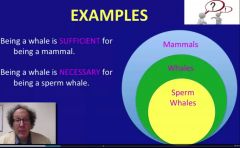
sufficient, necessary. See picture as left to get a visual representation.
Notice how the comparisons are of a set to a subset.
SUFFICIENT says being in a subset of a set is SUFFICIENT for being in the set.
On the other hand, NECESSARY (REQUIRED) says being in a set is NECESSARY (REQUIRED) for being in a subset of the set. |
|
|
Week 08 Causal Reasoning
The following is a definition of ________________.
F (subset) is a ___________ condition for G (set), if and only if,
For events: Whenever an event F (subset) happens, an event G (set) also happens
For features: Anything that has feature ____ (subset) also has feature G (set). |
SUFFICIENT, Sufficient, F
In my own words, SUFFICIENT says being in a subset of a set is SUFFICIENT for being in the set. |
|
|
Week 08 Causal Reasoning
The following is a definition of ________________.
F (set) is a ___________ condition for G (subset), if and only if,
For events: Whenever an event F (set) does NOT happen, an event G (subset) also does NOT happen
For features: Anything that does NOT have feature ____ also does NOT have feature G. |
NECESSARY Necessary, F
In my own words, NECESSARY (REQUIRED) says being in a set is NECESSARY (REQUIRED) for being in a subset of the set.
Notice that the only difference between this definition and SUFFICIENT is that NECESSARY negates the definition of SUFFICIENT. |
|
|
Week 08 Causal Reasoning
By putting negation on both sides of the definition for SUFFICIENT makes the conditions to become ____________________. |
NECESSARY. |
|
|
Week 08 Causal Reasoning
How can SUFFICIENT and NECESSARY be explained in terms of propositional logic |
If...then...
F⊃G
and
If not...then not...
˜F⊃˜G
It's not quite this because there are no quantifiers as there're in propositional logic but it a sufficient (no pun intended) way of understanding SUFFICIENT and NECESSARY. |
|
|
Week 08 Causal Reasoning
If F is necessary for G, then ___ is sufficient for ____. |
G, F
This is a comparison of a set to it subset where F is a superset of G or G is a subset of F.
Example:
If being a whale is necessary for being a sperm whale, then being a sperm whale is sufficient for being a whale. |
|
|
Week 08 Causal Reasoning
The examples of SUFFICIENT AND NECESSARY apply in causal situations. However, there're a little bit ____________ to apply and the main reason it the word _____________ because it's a ___________ and it applies to a ____________ domain of discourse.
It only holds __________________ certain situations happen. |
trickier, whenever, quantifier, restricted, whenever |
|
|
Week 08 Causal Reasoning
Casual Examples
Striking this match is __________ for lighting it.
Striking this match on a rough surface is for lighting it.
Whenever someone strikes the match, it lights, not _______.
Give examples of when this would not be true. |
sufficient, necessary, true.
Perhaps, if the match gets wet or one does not use a rough surface. |
|
|
Week 08 Negative Sufficient Condition Test
The negative sufficient test lets us know what is _________ sufficient for this requirement |
not. |
|
|
Week 08 Negative Sufficient Condition Test
The positive sufficient test lets us know what is _________ for this requirement |
sufficient |
|
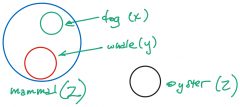
Week 08 Negative Sufficient Condition Test
What is the NEGATIVE sufficient condition test?
This is a ________ argument.
Looking at the diagram, left, are x, y, and z sufficient conditions of Z |
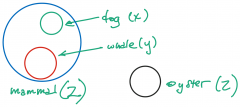
X is NOT a SUFFICIENT condition of Y if there is any case where X is present a Y is absent.
deductive
x and y are sufficient conditions of Z but Z is not. |
|
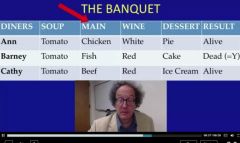
Week 08 Negative Sufficient Condition Test
Explain the table at left in term of its sufficiency for death?
Even though fish does not fail the ______________ sufficient condition test, it cannot be claimed that eating this fish is a sufficient condition for death.
In order to determine if this fish is a ______________ condition for death, the ____________ sufficient condition test must be applied.
|
Tomatoes, Chicken, Fish, and Beef are not sufficient for death
White and Red Wine is not sufficient for death
negative, sufficient, positive
|
|
|
Week 08 Negative Sufficient Condition Test
Is the following an alliteration?
Imagine that some diners died directly after dinner
What is an alliteration?
|
Yes.
al·lit·er·a·tion əˌlitəˈrāSHən/ noun
|
|
|
Week 08 Negative Sufficient Condition Test
Imagine that some diners died directly after dinner. (Alliteration!) We know that something they ate caused the deaths. This is all they ate:
Based on the data in Question 4, which of the following does the case of Carol rule out as sufficient for death? |
Notice this question only asked about Carol so , just in the case of Carol, "Nothing" can be ruled out since she died. Think of it as she was the only person that died.
However, looking at the other cases, there're things that can be rule out except cake.
The correct answer is "Nothing." Carol died, so she cannot be a case where a diner had something (X is present), and that diner did not die (Y is absent). Thus, Carol cannot show that any item fails the negative sufficient condition test, so she cannot show that anything is not sufficient for death. This applies to what Carol did not have as well as to what she did have. Remember that it is only cases where the target feature (Y; here = death) is absent that can show that anything is not sufficient for death. |
|
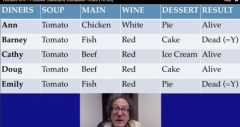
Week 08 Positive Sufficient Condition Test
What are the four conditions for having a good reason to believe X is a SUFFICIENT condition of Y if ALL of the following conditions are met?
In the slide on the left notice how both Barney and Emily died, and 3 of the 4 elements they ate are the same. The food items that are different between the two of them is Cake and Pie.
How does step 3 of the positive sufficient Condition Test help rule out one of these elements?
|
This test is still defeasible if we get additional data that contradicts what we know as true. |
|
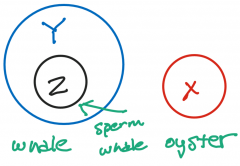
Week 08 Negative Necessary Condition Tests
What is the Negative Necessary Condition Test?
In the diagram, left, is x a necessary condition of y?
Is z a necessary condition of y? |
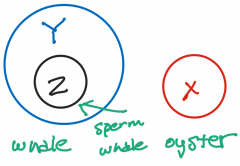
X is not a necessary condition of Y if there is any case where X is absent and Y is present.
|
|
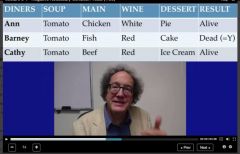
Week 08 Negative Necessary Condition Tests
In the diagram, left, does it imply that pie is not necessary for death? What does the case with Ann tell us about "Pie"?
|
The case with Barney tells us that "Pie" is not necessary for death whereas the for Ann tells us that "Pie" is not sufficient for death. |
|
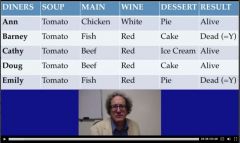
Week 08 Negative Necessary Condition Tests
In the diagram, left, is fish a necessary condition for death? |
Maybe, it's in the "field of candidates" because two people died after eating it but we have to confirm that with the Positive Necessary Condition Test. |
|
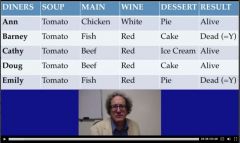
Week 08 Positive Necessary Condition Test
What are the four conditions for having a good reason to believe X is a NECESSARY condition of Y if ALL of the following conditions are met?
What can Harold and Getrude tell us about necessary conditions for death? |
Just switch present and absent from the Positive Sufficient Case (think about the mammal, whale, sperm whale illustration)
Nothing, Harold and Getrude did not die so they cannot tell us anything about what necessary conditions are for death. This test is still defeasible if we get additional data that contradicts what we know as true. |
|
|
Week 08 Complex Conditions
What is the definition for Complex Conditions? |
Complex conditions are candidates that are combinations of candidates or features. In other words, you can have more than one thing that caused a death in our examples like red wine and fish.
It could also be a negation like not having fish, or it could be a disjunction like having fish or beef. |
|
|
Week 08 Complex Conditions
What is the Negative Test For Conjunctive Sufficient Condition? |
Given (|) (W&X) is not a sufficient condition of Y if there is any case where (W&X) is present and Y is absent. |
|
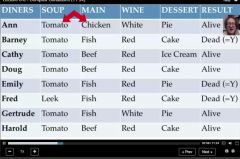
Week 08 Complex Conditions
In the diagram, left, are the following conjunctions sufficient conditions for death
|
Note: The last two bullets pass the negative sufficient condition test but it has this data has to go through the positive test before we can make an inductive inference. |
|
|
Week 08 Complex Conditions
What is the Negative Test For Conjunctive Necessary Condition? |
Given (|) (W&X) is not a necessary condition of Y if there is any case where (W&X) is absent and Y is present. |
|
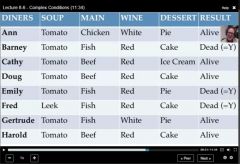
Week 08 Complex Conditions
In the diagram, left, are the following conjunctions necessary conditions for death
Fish & Red wine |
Barney and Emily had, so no, they both died. Fred had so no, he died.
Everybody who had Fish & Red Wine died.
Given (|) the data we have so far, Fish & Red wine are sufficient and necessary conditions for death.
Therefore, the chef killed them, maybe. This is a good example of how inductive arguments never give us 100% certainty, different from deductive arguments. |
|
|
Week 08 Complex Conditions
How do the Positive Test For Conjunctive Sufficient Condition and Positive Test For Conjunctive Necessary Condition compare to the Positive Sufficient Condition Test and Positive Necessary Condition Test? |
They are EXACTLY the same; just substitute in the conjectives. |
|
|
Week 08 Complex Conditions
Inductive arguments never make you ________________ certain that the inference (conclusion) is true. |
absolutely |
|
|
Week 08 Correlation vs. Causation
Some casuals relationships are not _______ or white, that is, dichotomous. They're are degrees of causal ________________ like CO2 and global warming.
By the same logic, one conclude that a heavy person ran the mile in 10 minutes ____________ because that person is heavy, but we know that heavy is not a sufficient or necessary condition to run the mile slow but we can still use _______________ relationships because certain properties come in degrees. |
black, relationships. We can't use the Sufficient Condition Test or the Necessary Condition Test but one can still come to a reason conclusion like CO2 reflects heat back at the earth like the greenhouse effect even though CO2 can be present and the earth still cool.
causal |
|
|
Week 08 Correlation vs. Causation
What test did John Stuart Mill's develop and to what does it apply? |
He developed the Method of Concomitant Variation and it applies to causal reasoning and cases that occur in degrees or some extent of causation.
He also developed test that the Necessary and Sufficient Condition test parallel. |
|
|
Week 08 Correlation vs. Causation
What does Concomitant mean? |
It means correlation. |
|
|
Week 08 Correlation vs. Causation
Explain positive and negative correlations? |
X and Y are positively correlated when they move in the same direction, that is, X increases and Y increases or conversely X decreases and Y decreases
X and Y are negatively correlated when they move in opposite directions. |
|
|
Week 08 Correlation vs Causation
________________ is sufficient for correlation, and causation is necessary for ___________. |
Causation, correlation. |
|
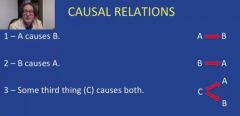
Week 08 Correlation vs. Causation
In the diagram at left, would A&B be correlated under phenomena (3)?
Give an example of 4. |
Yes. An example would be yellow teeth and lung cancer. Smoking cause them both but yellow teeth are associated with lung cancer because of smoking.
Another example, as children feet get bigger, their handwriting gets better. This is a function of maturation.
The height of my son and the height are tree are correlated. You might say maturation or time is the responsible variable. Unlike the hand and feet being a function of the same person but the tree and the son are not related. And time is an abstract thing that is a background condition instead of a cause in and of itself. |
|
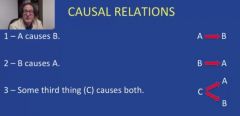
Week 08 Correlation vs. Causation
If A causes B, then A has to be instantiated or ___________ before B. |
happen. In cases 3 and 4, the temporal order of A and B do not have to have an order as in case 1 and 2. |
|
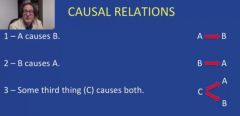
Week 08 Correlation vs. Causation
How can experimentation be used to determine causation? |
Through manipulation of variables such as A or B. This course does not go into detail on this subject but for more information Woodward and Pearll can be referenced. |
|
|
Week 08 Correlation vs. Causation
How was the cigarettes industries' argument that lung cancer caused smoking because of something that caused them to want to smoke if they had lung cancer. |
Through manipulation where monkeys without lung cancer were forced to smoke and they develop lung cancer. |
|
|
Week 08 Correlation vs. Causation
An economist friend to Professor Walter Sinnott-Armstrong said that kids in the 60s with Televisions in their homes actually performed better in school, and some people concluded that everyone needed TVs in the home. Later in the 90s, it was discovered that kids with TVs in the home did worse. |
The affluent, the higher socio-economic people are the ones who owned TVs in the 1960s. |
|
|
Week 08 Causal Fallacies
Describe Common Fallacies |
|
|
|
Week 09 Why Probability Matters
What is the Gambler's Fallacy? |
Thinking there are hot streaks like dice getting hot or shooter's streak in basketball. |
|
|
Week 09 Why Probability Matters
What is heuristic?
What is the Representativeness Heuristic? |
heu·ris·tic hyo͞oˈristik/ adjective
enabling a person to discover or learn something for themselves. "a “hands-on” or interactive heuristic approach to learning"
That a winning hand in poker (e.g. 4Qs and an Ace) is less likely than a run-of-the-mill hand (like a 9,8,5,J,4) but the two are equally probable.
That is due to the problem you thinking winning hands are less representative of what actually happens because you get less winning hands. |
|
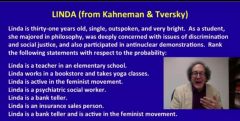
Week 09 Why Probability Matters?
In the diagram, left, most people rated the probability of Linda being a bank teller and active in the feminist movement higher. Is this correct? Why or why not? |
It is correct. People tend to make decisions based on what they know as representative,falling into the trap of The Representativeness Heuristic. Their intuition fails them.
In probability, the chance of independent events occurring simultaneously are less likely than each of the events occurring by itself. |
|
|
Week 09 Why Probability Matters?
What is the Monte Hall Problem from "The Price is Right"? |
A chance of winning a car behind 1 of 3 doors. The other 2 doors have a goat behind them. You pick door A. Then the host (Monte Hall) opens door C and reveals a goat behind it. Then he offers you the chance to switch to door B. Should you accept his offer to switch? Why or why not? |
|
|
Week 09 What is Probability?
What is probability? |
The chance of something happening which is different from possible. |
|
|
Week 09 What is Probability?
What types of Probability are there? |
|
|
|
Week 09 What is Probability?
If the probability of an event is 1 then it is ___________ it will happen. |
certain. |
|
|
Week 09 Rules of Probability - Negation
What is the Probability of Negation |
Rule 1: Probability of Negation
is the probability that an event will NOT occur is one minus the probability that it will occur. It is the compliment.
The notation is Pr(~h) = 1 - Pr(h) h stands for the hypothesis or event ~ stands for negation -Pr(h) stands for the probability of h
Pr(h) + Pr(~h) = 1 because it is certain that one of the events will occur. |
|
|
Week 09 Rules of Probability - Conjunction
What is the Probability of a Conjunction for independent events? |
Rule 2: Probability of a Conjunction for independent events
Two events are independent if and only if the occurrence of one has no effect on the probability of the other.
Rule 2: If two events are independent, the probability of both events occurring is the product of the probability of the first event occurring times the probability of the second event occurring.
These events are di or events with replacement. Replacements return events to original probabilities.
With di, the probability of getting two heads in a row is (also can be thought of as flipping two fair coins)
Symbolically:
Pr(h&h) = Pr(h) * Pr(h) = .5 * .5
Think back to the example of Linda as a bank teller or a bank teller and a female activist, since these events are independent, the chances of them both occurring together versus one occurring by itself is lower. |
|
|
Week 09 Rules of Probability - Conjunction
In a standard deck of card what are the odds of picking a 4 of club, using independent events, that is, the chance of choosing a 4, and the chance of it being a club? |
chance of a 4 if 4/52 = 1/13 chance of a club is 13/52 = 1/4
P(4 and club) = P(4) * P(club) since these events are independent with the first card being replaced.
P(4 and club) = 1/13*1/4 =1/52
This makes sense, since there is only one 4 of club in a standard card deck. |
|
|
Week 09 Rules of Probability - Conjunction
What is the probability of picking 1 of the 4 aces on the first pick and then on the second pick after replacement? |
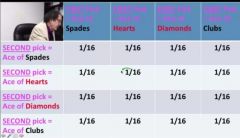
|
|
|
Week 09 Rules of Probability - Conjunction
What is the Probability of a Conjunction for any events (dependent or generalized rule) called, and describe it? |
It is called a conditional probability. It states the conditional probability of X given Y is the percentage of cases where X occurs out of the cases where Y occurs.
Rule 2: Probability of a Conjunction (generalized for any events)
The probability of both of two events occurring is the product of the probability of the first occurring times the conditional probability of the second occurring given that the first occurred.
Note that this method works for independent events as well. The only difference is with this method, one of only has to consider the probability of the second event occurring.
Pr(h1&h2) = Pr(h1) * Pr(h2|h1)
|
|
|
Week 09 Rules of Probability - Conjunction
Two events are independent (in the sense used in the rules from probability) if and only if
(a). They cannot possibly both occur together (b). Whether or not one of the events occurs does not affect the probability that the other event will occur. |
(b) |
|
|
Week 09 Rules of Probability - Conjunction (Intersection)
The conditional probability of one event (X) given another event (Y) is |
The percentage of cases where X occurs out of the cases where Y |
|
|
Week 09 Rules of Probability - Disjunction (Union)
What are alternative words for conjunction and disjunction? |
union and intersection, respectively. |
|
|
Week 09 Rules of Probability - Disjunction (Union)
What is another name for the probability of a disjunction?
What is the formula?
|
Rule 3: Probability of a Disjunction
Two events are mutually exclusive if and if only and they cannot occur together, so the probability of both events occurring together is zero.
Symbolically, that is, Pr(h1&h2) = 0
Rule 3: If two events are mutually exclusive, then the probability of either one or the other occurring is the sum of the probability of the first occurring plus the probability of a second occurring.
Symbolically:
P(h1Vh2) = P(h1) + P(h2) where these events are mutually exclusive |
|
|
Week 09 Rules of Probability - Disjunction (Union)
What is a permutation? |
This is a conjunction. Permutations are ordered (for instance, heads first and then tail second) events. |
|

Week 09 Rules of Probability - Disjunction (Union)
What is a combination? Does this slide disjoin two combinations? |

Combinations are unordered (for instance, heads and tails in two flips). In this case one could have a conjunction and a disjunction as in the diagram at left.
Yes, it does. |
|
|
Week 09 Rules of Probability - Disjunction
What is the Probability of a Disjunction for any events (generalized rule) called, and describe it? |
It is the addition rule,
Rule 3G: Probability of a Disjunction (generalized for any events)
The probability of either one event or another occurring is the sum of the probability of the first event occurring plus the probability of the second occurring minus the probability of both events occurring together.
Symbolically,
Pr(h1 V h2) = Pr(h1) + Pr(h2) - Pr(h1 & h2)
|
|
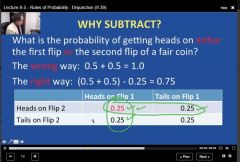
Week 09 Rules of Probability - Disjunction
What is the probability of getting heads on either the first flip or the second flip of a fair coin? |

Must use the addition rule or the Probability of a Disjunction
.5 + .5 - .25 = .75
See diagram, on front of slide, to see why .25 (the intersection, conjunction) must be subtracted out. That is the occurrence of Heads on Flip 1 and Heads on Flip 2. It would get added twice when adding the column of Heads on Flip 1 and the row of Heads on Flip 2, thereby adding .25+.25+.25+.25 so it Heads of Flip 1 and Heads on Flip 2, .25, would have to be subtracted out. See the Bayes Inference at left to see how arriving at a solution is much easier.
|
|
|
Week 09 Rules of Probability Disjunction
For Bayes Inference, describe Conjunction (Antecedent and Descendent) and Disjunction (across branches) and how they should be multiplied using conditional probability or added using addition rule to arrive at probabilities? |
The Bayesian Inference is analogous to a family tree where antecedent and descendants are multiplied using conditional probabilities (conjunctions) and members across branches are added using the addition rule (disjunctions). Both cases yield probabilities from conjunction or disjunction. |
|
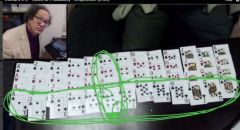
Week 09 Rules of Probability Disjunction
What is the probability of getting a 6 or a club from a standard deck of cards?
See diagram, left, Professor Walter Sinnott-Armstrong's illustration as a reference. |
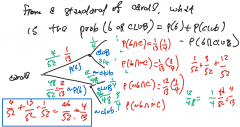
There are several ways to solve this problem. I used Bayes Inference starting with P(6) as the starting point and negating following each node to get the P(E) and P(~E). The two branches following a node must sum to one as they are complements (or the negated components of each other).
The box at the bottom left is the alternative method of solving this problem. Notice it has three elements in the solution. Each representing the components of the addition rule, that is, P(6) + P(club) - P(6&club).
If the professors diagram is reference, notice how (P6&club) = 1/52 has to be subtracted out because it is enclosed twice in the illustration as the P(heads on the First flip) or P(heads on the second flip) occurred twice. |
|
|
Week 09 Rules of Probability - Disjunction
If two events are NOT mutually exclusive, then the probability of either one event or the other event occurring is |
The sum of the probability of the first event plus the probability of the second event minus the probability of both the first event and the second event occurring together.
Note the last component of this "addition rule" is not a factor if the events are mutually exclusive because that component's probability is zero. |
|
|
Week 09 Rules of Probability - Disjunction
Assuming that all card picks here are fair, what is the probability of picking an eight and a nine in any order when you pick two cards out of a standard deck (when you put the first card back and shuffle the cards before the second pick)? |
The key wording here is any order. |
|
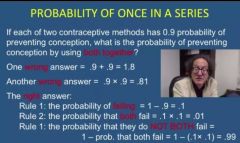
Week 09 Rules of Probability - Series
What is the Probability Of Once In A Series
Apply to the diagram. |
Rule 4: The probability that an event will occur at least once in a series of independent trials is one minus the probability that it will not occur in that series.
Symbolically,
1-Pr(~h)^n (n=the number of trials)
As another example, thinking about flipping a coin and getting a heads in five flips. The probability of getting at least one head is
1-(.5)^5 |
|
|
Week 09 Bayes Theorem Honors
Derive Bayes' Theorem, Bayes was an __________ century Mathematician |
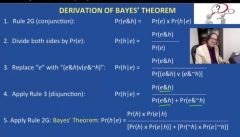
18th |
|
|
Week 09 Expected Financial Value
Name the 3 Types of Decisions |
|
|
|
Week 09 Expected Financial Value
What is the definition of Decisions with Certainty |
The chooser knows the actual outcomes of each option or alternative action rather than just the probabilities of the outcomes.
There's nothing really certain though. |
|
|
Week 09 Expected Financial Value
What is the definition of Decisions with Risk? |
The chooser does not know the actual outcomes of each option or alternative action but does know the probabilities of the outcomes. |
|
|
Week 09 Expected Financial Value
How are decisions under risk commonly made? |
The expected value theory |
|
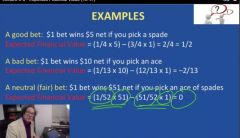
Week 09 Expected Financial Value
How is the Expected Monetary (or Financial) Value of Choice calculated? |
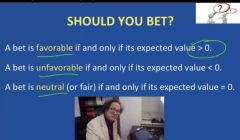
P(winning) * Net Gain in Money of Winning - P(losing) * Net Loss in Money of Losing |
|
|
Week 09 Expected Overall Value
What is Diminishing Marginal Utility? |
Each increment decreases in value as you more and more increments. |
|
|
Week 09 Expected Overall Value
What is Actual Overall Value |
It is utility of an act and is all of the good and bad effects that the act actually has. |
|
|
Week 09 Expected Overall Value
What is Expected Overall Value?
Some economies have formulas for figuring out ___________ and multiplying by the ______________ of those preferences. |
It is expected utility of an act and is all of the good and bad effects of the act times the probability of each effect.
So it bring not only the value but also the probabilities.
This is hard to calculate.
preferences, probabilities |
|
|
Week 09 Expected Overall Value
What is a Decision with Ignorance? |
The chooser does not know the actual outcomes of the options or alternative actions and also does NOT know even the probabilities of those outcomes. |
|
|
Week 10 Introduction to Fallacies?
What is a fallacy? |
A fallacy is a kind of bad argument. Not all bad arguments are fallacies. Some arguments are bad because their premises are false.
But a fallacy is an argument that is bad because its premises don't support the conclusion, whether or not the premises are true. They are not the right types of premises |
|
|
Week 10 Introduction to Fallacies?
Give examples of fallacies. |
Fallacy 1
The majority of violent crime in the United States is committed by men who earn less than $30K/yr. (This is true). ----------------------------------------------------------------------- Therefore, when you see a man who earns less than $30K/yr., he is likely to be a violent criminal.
Fallacy 2
If the national government increases spending, investors will lose confidence in the national currency.
Investors have lost confidence in the national currency. ----------------------------------------------------------- The national government must have increased spending. |
|
|
Week 10 Introduction to Fallacies
Give an example of a bad argument that is not a fallacy. |
Most of the crude oil in the work in is Texas. (This is not true)
Texas is going to secede from the United States. (This is not true). --------------------------------------------------------------------- Therefore, domestic oil availability in the US is going to plummet. (This is true but the premises are false). |
|
|
Week 10 Argument from the Heap
What is "Argument from the Heap" or sometimes called the ______________ ________________ which comes from the Greek word soros. |
It might or might not be a fallacy but it opposes a linguistic phenomena called vagueness, and that does create fallacies.
Sorites argument, soros.
|
|
|
Week 10 Argument from the Heap
What is a paradox of the heap? |
The word "sorites" derives from the Greek word for heap. The paradox is so named because of its original characterization, attributed to Eubulides of Miletus.[6] The paradox goes as follows: consider a heap of sand from which grains are individually removed. One might construct the argument, using premises, as follows:[5] 1000000 grains of sand is a heap of sand (Premise 1) A heap of sand minus one grain is still a heap. (Premise 2) Repeated applications of Premise 2 (each time starting with one fewer grain) eventually forces one to accept the conclusion that a heap may be composed of just one grain of sand (and consequently, if one grain of sand is still a heap, then removing that one grain of sand to leave no grains at all still leaves a heap of sand; indeed a negative number of grains must also form a heap[7]). Read (1995) observes that "the argument is itself a heap, or sorites, of steps of modus ponens":[8] 1000000 grains is a heap. If 1000000 grains is a heap then 999999 grains is a heap. So 999999 grains is a heap. If 999999 grains is a heap then 999998 grains is a heap. So 999998 grains is a heap. If ... ... So 1 grain is a heap.
(Source: Wikipedia) |
|
|
Week 10 Argument of the Heap
What is a variation of the paradox of the heap? |
Another formulation is to start with a grain of sand, which is clearly not a heap, and then assume that adding a single grain of sand to something that is not a heap does not turn it into a heap. Inductively, this process can be repeated as much as one wants without ever constructing a heap.[3][5] A more natural formulation of this variant is to assume a set of colored chips exists such that two adjacent chips vary in color too little for human eyesight to be able to distinguish between them. Then by induction on this premise, humans would not be able to distinguish between any colors.[3] This paradox can be reconstructed for a variety of predicates, for example, with "tall", "rich", "old", "blue", "bald", and so on. Bertrand Russell argued[9] that all of natural language, even logical connectives, is vague; moreover, representations of propositions are vague. However, most views do not go that far, but it is an open question. |
|
|
Week 10 Argument of the Heap
Definition of the sorites paradox |
The sorites paradox (/soʊˈraɪtiːz/;[1] sometimes translated as the paradox of the heap because in Ancient Greek: σωρίτης sōritēs means "heap")[2] is a paradox that arises from vague predicates.[3] A typical formulation involves a heap of sand, from which grains are individually removed. Under the assumption that removing a single grain does not turn a heap into a non-heap, the paradox is to consider what happens when the process is repeated enough times: is a single remaining grain still a heap? (Or are even no grains at all a heap?) If not, when did it change from a heap to a non-heap? |
|
|
Week 10 Argument of the Heap
What does the Greek word soros mean? |
heap. |
|
|
Week 10 Argument from the Heap
What is a Gazillion? |
rom Gazzen, from Latin “earthly edge”, or end of the earth, abbreviated to gaz (literally 28810 ancient Greek miles, been one full revolution of the globe) So how much is a Gazillion? |
|
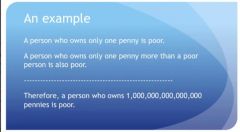
What does the Principle of Mathematical Induction say about the argument at left. |
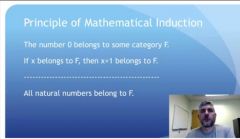
The problem with the argument of the front of this card is that it combines an amount (number) with a class of people, and we know that there is more than one class of people.
Thinking back to sufficiency and necessary. Having a penny is a sufficient condition for being poor, considering the conditions for being poor. However, having a gazillion pennies is not a sufficient condition for being poor. Inconclusive, still need to develop "necessary". Also, definition is questionable based on the definition of net worth. |
|
|
Week 10 Argument from the Heap
What is a paradox? |
A paradox is an argument in which all of the premises seem to be obviously true, the argument seems to be obviously valid, and yet the conclusion seems to be obviously false.
Some paradoxes are fallacies, because, despite appearances, the argument is not valid. |
|
|
Week 10 Argument from the Heap
Vagueness
When is an expression vague? |
An expression is vague when there is no precise boundary between the cases to which it correctly applies and the cases to which it does not.
Examples:
|
|
|
Week 10 Argument from the Heap
Why vagueness leads to paradox? |
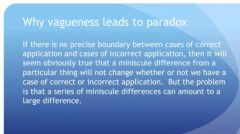
Miniscule differences can appear to not cross any thresholds but many changes can become big ones, "clouding the waters" |
|
|
Week 10 Argument from the Heap
Examples of vagueness. |

|
|
|
Week 10 Vagueness
What is a paradox of vagueness? |
a paradox of vagueness is a seemingly valid argument, whose first premise claims that an item lacks (or has) a certain feature, and whose second premise points out that a tiny, incremental change cannot make the difference between having that feature and lacking it. The paradox will conclude that the item in question can never acquire (or lose) the feature in question, no matter how much it changes. |
|
|
Week 10 Conceptual Slippery Slopes
What is a "Conceptual Slippery Slope"? |
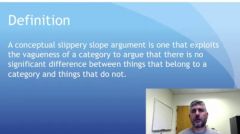
|
|
|
Week 10 Conceptual Slippery Slopes
Give an example of a conceptual slippery slope using short as a category. |
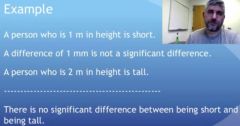
This argument says there is a difference in height, short and tall, but it's not significant.
This is a fallacy because the premises don't support the conclusion. |
|
|
Week 10 Conceptual Slippery Slopes
Give another example of a conceptual slippery slope using a penny as a category. |
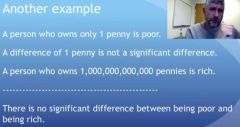
Think of this in terms of group power versus the power of the individuals in the group, which may be none or little even though the group power is much. |
|
|
Week 10 Fairness Slippery Slopes
What is the definition to a Fairness Slippery Slope?
|
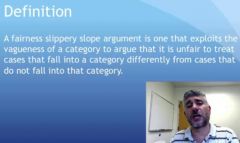
They are fallacies because they assume something that might not be true |
|
|
Week 10 Fairness Slippery Slopes
Give an example of a Fairness Slippery Slope argument using grading |
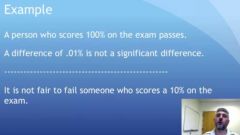
|
|
|
Week 10 Fairness Slippery Slopes
Give an example of a Fairness Slippery Slope argument using not aborting a 9-month old human fetus |

|
|
|
Week 10 Fairness Slippery Slope
Usually when someone gives a "Fairness Slippery Slope" argument they usually say "Well, where do you draw the ______________________" |
line,
LOL, response, at 70%, respondee, "Well, that's not fair" |
|
|
Week 10 Causal Slippery Slopes
What is a Causal Slippery Slope argument? |
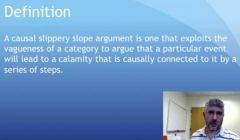
This is a fallacy too. |
|
|
Week 10 Causal Slippery Slopes
What are other names for a Causal Slippery Slope. The idea is there're a _____________ of steps that eventually ______________ lead to some horror. |
Domino argument or a parade of horrors.
series, will
|
|
|
Week 10 Causal Slippery Slopes
Give an example of of a Casual Slippery Slope using euthanasia. |

In another example, dating leads to marriage with a 66% probability, and 66% of married people get divorced, and divorced people are not on speaking terms with each other, so, does the fact that you're dating you'll likely end up not speaking.
This is a slippery slope because in the chain, the probability will reduce. |
|
|
Week 10 Causal Slippery Slopes
Give an example of a Casual Slippery Slope using allowing birth control in high school and elementary |
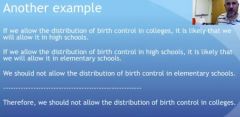
|
|
|
Week 10
Name the fallacies from the week. |
|
|
|
Week 10 Causal Slippery Slope
Look at the Causal Slippery Slope |
If we start requiring automatic weapons owners to pass an automatic weapons safety test, then it's likely that we will start to require gun owners to pass a gun safety test. Your AnswerScoreExplanation (a) We should not start requiring toy owners to pass a toy safety test. (b) We should start requiring toy owners to pass a toy safety test. (c) Whatever we require of automatic weapons owners we must also require of toy owners. (d) Any of the above. (e) None of the above.Inorrect0.00 Total0.00 / 1.00 Question Explanation |
|
|
Week 10 Ambiguity
What is an ambiguous expression |
An expression is ambiguous when it has more than one acceptable interpretation |
|
|
Week 10 Ambiguity
Ambiguity is a ________________ in every spoken language |
problem |
|
|
Week 10 Ambiguity
Why does ambiguity lead to fallacy? |
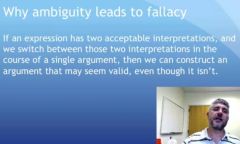
|
|
|
Week 10 Ambiguity
See the example of a fallacy due to ambiguity. |
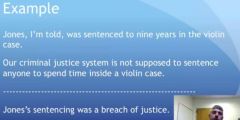
|
|
|
Week 10 Ambiguity
See another example of a fallacy due to ambiguity. |
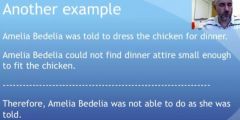
|
|
|
Week 10 Semantic and Syntactic Ambiguity
What is Semantic Ambiguity?
See examples.
|

When a particular word has two different interpretations |
|
|
Week 10 Semantic and Syntactic Ambiguity
See example of semantic ambiguity leading to fallacy (invalid)
|

The wrong interpretation is assigned to the word stoned. |
|
|
Week 10 Semantic and Syntactic Ambiguity
See another example of semantic ambiguity leading to fallacy (invalid) |

|
|
|
Week 10 Semantic and Syntactic Ambiguity
What is syntactic ambiguity? |

Two different interpretations where the grammar interpretation is the difference.
|
|
|
Week 10 Fallacies of Equivocation What is a fallacy of equivocation? |
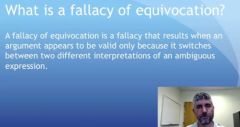
|
|
|
Week 10 Fallacies of Equivocation Give an example of a fallacy of equivocation. |
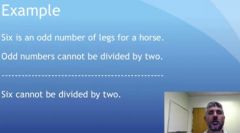
|
|
|
Week 10 Fallacies of Equivocation
Give another example of a fallacy of equivocation. |

|
|
|
Week 10 Fallacies of Equivocation Suppose that Dr. Spock (or some other authority on parenting) offered the following argument: “It is very important for parents not to let down their children. I am now carrying my child. Therefore, even though he wants to walk on his own, it is important that I not let him down.” This argument is a Your AnswerScoreExplanation a. conceptual slippery slope fallacy b. fairness slippery slope fallacy c. fallacy of ambiguityCorrect1.00 d. all of the above e. none of the above |
The term “let down” means more than one thing. On one hand, the term “let down” means “allow to move downward.” On the other hand, when used to describe people, the term “let down” can also mean “emotionally disappoint.” Because the term “let down” means both of these things, the sentence, “it is very important for parents not to let down their children” might mean that it is important for parents to not let their children move downward, as the argument assumes. However, it is also possible, and far more likely, that the term “let down” means different things in different parts of the argument, and that the sentence means that parents should not emotionally disappoint their children. Because the argument ignores the ambiguity in “let down,” the argument commits a fallacy of ambiguity |
|
|
Week 11 Fallacies of Relevance and Vacuity
When does a fallacy of ambiguity occur? |
A fallacy of ambiguity occurs when an argument exploits the fact that a word means more than one thing. |
|
|
Week 11 Fallacies of Relevance and Vacuity What is the difference between fallacies of vagueness and ambiguity and fallacies of relevance and vacuity? |
the former are much more difficult to avoid than the latter. |
|
|
Week 11 Fallacies of Relevance and Vacuity Why are fallacies of vagueness and ambiguity hard to avoid? |
Because we speak a language of vagueness and ambiguity. The questions become why don't we speak a language that avoid these things. There are communities who try to purge their communities such as scientific communities of this problem. |
|
|
Week 11 Fallacies of Relevance and Vacuity Why do we have language of vagueness and ambiguity? |
Prof. Ram Neta believes it's necessary, sometimes to answer questions like when you are traveling on vacation, and someone ask you when you're traveling, and because of all the variables you might have to be vague because you don't know exactly when you're going.
I believe, also, when using metaphors, language can be vague but they contribute to our quality of life. |
|
|
Week 11 Fallacies of Relevance and Vacuity What are fallacies of relevance? |
A fallacy of relevance is a fallacy that results when an argument's premises are not relevant to supporting it conclusion
Ad hominem Appeal to authority Appeal to popular opinion |
|
|
Week 11 Fallacies of Relevance and Vacuity What are fallacies of vacuity? |
A fallacy of vacuity is a fallacy that results when can't be justified in acccepting the premises uless your are independently justified in accepting the conclusion
Circularity Begging the question Self-sealing |
|
|
Week 11 Fallacies of Relevance and Vacuity
What is vacuity? |
a·cu·i·ty əˈkyo͞oədē/ noun
|
|
|
Week 11 Fallacies of Relevance and Vacuity
What does Ad Homimen mean and what type of argument is it? |

It means in Latin to the person. |
|
|
Week 11 Fallacies of Relevance and Vacuity
What are 3 things that a person is doing in giving an argument? |
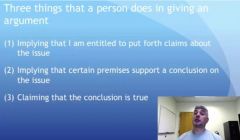
In Ad hominem arguments, this is what the opponent is going after. |
|
|
Week 11 Fallacies of Relevance and Vacuity
What are the 3 types of Ad hominem arguments? |
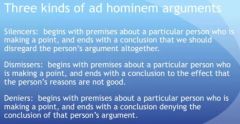
|
|
|
Week 11 Fallacies of Relevance and Vacuity
T or F Some silencer arguments are fallacies and some are not.
|
T |
|
|
Week 11 Fallacies of Relevance and Vacuity
An example of a silencer that is not a fallacy (good arguments). |

Assume some breaks into a courtroom and outburst in this way.
This might be sound but that doesn't mean the court should listen to it.
In fact, the jury might be instructed not to listen to the outburst.
|
|
|
Week 11 Fallacies of Relevance and Vacuity
An example of a silencer that is not a fallacy (good arguments). |
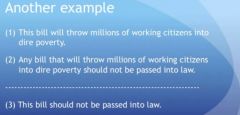
Assume that someone burst into a legislative session, and is asked to be disregarded by a member of the legislature.
|
|
|
Week 11 Fallacies of Relevance and Vacuity
An example of a silencer that is a fallacy (bad arguments). |
Don't listen to that person because they have (or are)
This type of silencers are fallacies. |
|
|
Week 11 Fallacies of Relevance and Vacuity
An example of a dismisser that is likely to be a fallacy because every business is in business to make money at a minimum but it could be a good argument. It's hard to know. |

Saying that the fossil fuel industry has ulterior motive (if you say that someone has an ulterior motive for doing something, you believe that they have a hidden reason for doing it) |
|
|
Week 11 Fallacies of Relevance and Vacuity
An example of a dismisser that could be a good argument but it's hard to know without knowing the real reasons behind asking for a bigger budget. |
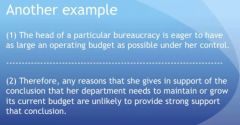
This argument is saying we should assume her reasons are false. |
|
|
Week 11 Fallacies of Relevance and Vacuity
An example of a denier ad hominem argument that is a good argument. |
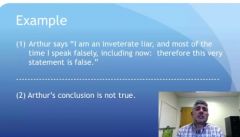
|
|
|
Week 11 Fallacies of Relevance and Vacuity
An example of a denier ad hominem argument that is a good argument. |
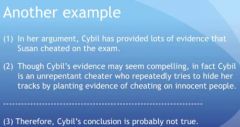
|
|
|
Week 11 Fallacies of Relevance: Appeals to Authority
What is Appeals to Authority and how are they related to ad hominem arguments? |
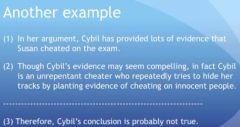
Think of it as the opposite of ad hominem. You commend or are in favorable of a person.
This reminds me of politicians speaking on party candidates after a debate like a presidential debate.
It concludes that a person should be given "extra" credit. |
|
|
Week 11 Fallacies of Relevance: Appeals to Authority
What are the three kinds of appeal to authority? |

|
|
|
Week 11 Amplifiers
An example of an amplifier argument |
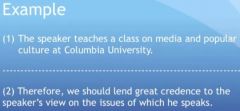
|
|
|
Week 11 Amplifiers
Another example of an amplifier argument |
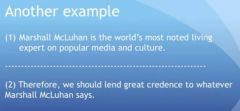
This argument is giving in contrast to a Columbia University Prof. who specializes in this subject.
This argument overrides the argument given by the Prof., according to Prof. Ram Neta |
|
|
Week 11 Supporters
Example of a good supporter argument. |
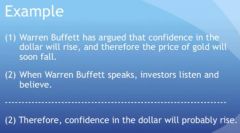
|
|
|
Week 11 Supporters
Example of a good supporter argument. |

This is not a deductively sound argument but it's a good argument. |
|
|
Week 11 Affirmers
Example of a good affirmer argument |

|
|
|
Week 11 Affirmers
Example of a good affirmer argument |
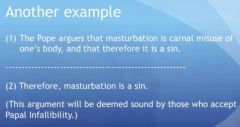
|
|
|
Week 11 Affirmers
|
An argument from authority is a supporter argument when it begins with a claim about a person, and concludes, based on the idea that the person’s testimony is reliable, that the testimony is to be believed. |
|
|
Week 11 Amplifier
What is an amplifier argument? |
An argument from authority, which is an amplifier, begins with a claim about a certain person, and concludes that, based on who she is, the person has a greater right to offer testimony on the matter, and that this testimony is more decisive. |
|
|
Week 11 Appeals to Popular Opinion
What is an Appeal to Popular Opinion? |
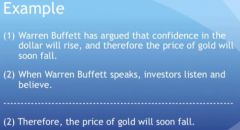
|
|
|
Week 11 Appeals to Popular Opinion
A good example of an Appeals to Popular Opinion |
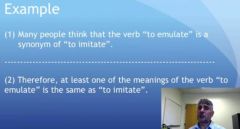
|
|
|
Week 11 Appeals to Popular Opinion
Another good example of an Appeals to Popular Opinion |
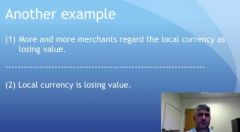
|
|
|
Week 11 Fallacies of Vacuity
What is a fallacy of vacuity? |
A fallacy of vacuity is a fallacy that results when an argument starts by assuming what it's suppose to establish. |
|
|
Week 11 Fallacies of Vacuity
What are the 3 types of fallacies of vacuity? |
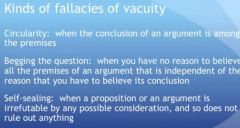
|
|
|
Week 11 Circularity and Begging the Question
What is circularity? |
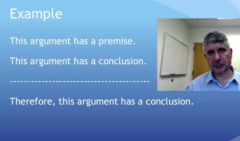
A fallacy of circularity is an argument where the conclusion of the argument is contained among the premises of the argument. This type of argument is hard to miss. |
|
|
Week 11 Circularity and Begging the Question
What is begging the question? |
This type of argument if a broader category of circularity since it is a fallacy that results when cannot have a reason to believe an argument's premises unless you have an independent reason to believe its conclusion.
So, the conclusion is assumed to be true, thereby, becoming a premise of the argument.
Not all arguments of begging the question include circularity. |
|
|
Week 11 Circularity and Begging the Question
Example of begging the question |

The argument is begging the question because it has premises with no reason to believe unless we already have a reason to believe the conclusion independently of the argument itself.
This is not an example of circularity because the conclusion is not precisely included among the premises (close but no cigar) |
|
|
Week 11 Self-Sealers
What are self-sealers?
See example
|

A self-sealer is a proposition is irrefutable because it does not claim anything, it does not rule out any conceivable situation.
One cannot put forth any evidence that the opponent will not accept.
They insist no matter what evidence is put forth. |
|
|
Week 11 Self-Sealers
Another example of a self-sealer |

|
|
|
____________ indicates that the sentence after it is more important than the sentence before it.
|
"But"
|
|
|
Consider the following valid argument? Australia is a continent---------------------------------:. Australia is continent Is this argument any good at justifying or explaining its conclusion?
|
It is not good at either justifying or explaining its conclusion. Because this argument is circular, anyone who does not believe its conclusion has just as much reason not to believe its premise, so it cannot justify its conclusion. It also cannot help help anyone understand why its conclusion is true, so it cannot explain its conclusion. This argument is still valid in the technical sense, so it illustrate one way in which a valid argument can fail to be any good.
|
|
|
Discuss how positive and negative evaluative words can have an opposite affect with combined with other words
|
Good --> GoodPretty Good ---> Not as Good as "Good" even though pretty is a "good" word by itselfPretty Darn Good --> Very good even though "darn" by itself indicates "bad"
|
|
|
Evaluation is another way to ____________ the skeptical regress by using language that is undefined like "that is good"
|
avoid
|
|
|
The word "too" is a __________ evaluative word because it makes a positive or neutral evaluative word become _____.
|
negative, bad For instance The food is spicy ---> Good to someThe food is "too" spicy ---> Bad for anyone saying it.
|
|
|
Week 01What are Arguments used for?
|
JustificationPersuasionExplanation
|
|
|
Week 02 Logicians make precise accounts of logical consequence with respect to a given _____________ by constructing a _____________ system for , or by formalizing the _______________ semantics for . Alfred Tarski highlighted three salient features for which any adequate characterization of logical consequence needs to account: (Source: http://en.wikipedia.org/wiki/Logical_consequence)
|
language, deductive, intended that the logical consequence relation relies on the logical form of the sentences involved,that the relation is a priori, i.e. it can be determined whether or not it holds without regard to sense experience, andthat the relation has a modal component.
|
|
|
Week 02Is evaluative language always bad? Some people believe you should not use evaluative language but ____________ describe.
|
No, just
|
|
|
Week 02People use discounting words to __________ an argument of their opponent.
|
head-off
|
|
|
Week 02The trick of discounting straw people. Why do they call them straw people.
|
You discount their objections and focus on your objections by focusing on the easy objections and taking focus off the hard objections. They call it straw because they are easy to knock over objections like straw people
|
|
|
Week 02Think about the ____________ you're applying when you _____________ evaluations.
|
standards, make
|
|
|
Week 02What is slanting?
|
Using an evaluative term without having reasons or justification for the evaluation Like calling someone an idiot or queer.
|
|
|
Week 02What is the other way to head off the skeptical regress besides discounting, assuring and guarding?
|
evaluation..
|
|
|
Week 02When do people use slanting?
|
Ironically, when they don't have a reason or justification. They use it to paper over their argument.
|
|
|
Week 02 A Problem for ArgumentsTricks for dealing with the skeptical regress
|
1. ASSURE audienceUse assumptions that everyone shares"Would you agree? to start the argument or get it to continue" for instance, Honda is generally a reliable car.2. DISCOUNT objections "but the study was better"3. GUARD your claim"probably" instead of definitely
|
|
|
Week 02 A Problem for ArgumentsWhat are the three ways to get rid of the problem of the skeptical regress?
|
1. Start with a premise that is UNJUSTIFIEDProblem: You could prove anything if you can't justify the premise but it's accepted.2. Use an argument with a CIRCULAR structure.Problem: In the smallest case(1) There is life on Mars.------------------------------------:. There is life on Mars.3. Use an INFINITE chain of arguments.Problem: There are at least three bacteria on Mars.__________________________________________:.There are least two bacteria on Mars__________________________________________:.There is at least one bacteria on Mars. The person making the argument could go on forever stating that there is "at least one more bacteria on Mars"
|
|
|
Week 02 A Problem for ArgumentsWhy is the regress called a SKEPTICAL regress?
|
Because it raises questions of whether and how any belief can be justified or known.
|
|
|
Week 02 Argument MarkersWhat are the three types of markers
|
PremiseReasonConclusion
|
|
|
Week 02 AssuringAssurance are not appropriate when
|
1. No one would question the claim anyway2. The authority is not trustworthy3. When you are able to give a full explanation without an authority.
|
|
|
Week 02 AssuringBenefits of Assuring
|
1. Saves time2. Helps avoid problem of Skeptical Regress
|
|
|
Week 02 AssuringExamples of guarding
|
somei believemight
|
|
|
Week 02 AssuringGive examples of guarding with probability
|
It's certainIt's probableIt's almost certainIt's beyond a reasonable doubt
|
|
|
Week 02 AssuringGive examples of mental guarding
|
Knowbelievetend to believeinclined to believe
|
|
|
Week 02 AssuringGive examples of The Tricks of Dropping Assurances
|
There are a lot of cannibals in GermanyHe says...It is reported that...Sources have said that...There are...
|
|
|
Week 02 AssuringGive the 3 types of assuring
|
1. Authoritative - Cites an authority. It does not necessary cite the information, stats , etc. It just cites the authority2. Reflexive - Prof calls it this. It references "self" I believe, I "feel" but it gets the other person to shut up. or I've held this opinion for years. (mental state of the speaker)3. Abusive - "Non-sense". Nobody but a fool would think. Eveybody knows this. A conditional abuse only if you disagree. It's just common sense...
|
|
|
Week 02 AssuringIt's guarding when you __________ a premise beyond what would otherwise be expected in the context.
|
weaken
|
|
|
Week 02 AssuringOne cannot make a premise more defensible by _________ it
|
weakening
|
|
|
Week 02 AssuringProblems with Assuring
|
Distracts with:1. That's obvious2. It's certain3. I'm sure
|
|
|
Week 02 AssuringWe want an assurance when
|
1. Someone might question the assurance2. The audience accepts the authority3. It would be too much trouble to cite all of the evidence.
|
|
|
Week 02 AssuringWhat are the 3 ways to guard?
|
ExtentProbabilityMental
|
|
|
Week 02 AssuringWhat does saying "I assure you that smoking is bad for your health"
|
You trying to convince someone based on your authority. Here if you haven't given the reason so you cut off the possibility of having to give a reason like the surgeon general says so or everybody knows that.
|
|
|
Week 02 AssuringWhat is guarding
|
Making your premises weaker to make it harder for opponent to disagree
|
|
|
Week 02 Close Analysis Part IWhat are the abbreviations for Close Analysis?
|
Reason Marker = RPremise Marker = PConclusion Marker = CAssuring Term = AGuarding Term = GDiscounting Term = DPositive Evaluative Term = E+Negative Evaluative Term = E-
|
|
|
Week 02 Discounting Fill in the following of putting an unguarded word in the mouth of an opponent. The President is in favor of a public health service, but a public health service is not going to solve _________ of the medical problems of our people.
|
all
|
|
|
Week 02 DiscountingArguers can combine the trick of __________ straw people with misuses of _______ and __________
|
discounting, guarding, assuring
|
|
|
Week 02 DiscountingHow is another way of saying the ring is expensive, but it is beautiful
|
The ring is expensive, BUT it is beautiful.
|
|
|
Week 02 DiscountingIf one was making an argument for buying an expensive ring which ones would be appropriate. 1. The ring is expensive, but it's beautiful2. The ring is expensive, and it's beautiful3. The ring is beautiful and expensive.4. The ring is beautiful, but it's expensive.
|
4 is the least acceptable. 2 and 3 could be appropriate depending on how one emphasizes it's beauty. 1 is the most appropriate
|
|
|
Week 02 DiscountingWhat are discounting words?
|
ButAlthoughEven ifEven ThoughNeverthelessNonethelessStill but not always discounting as in He's always sitting still.
|
|
|
Week 02 DiscountingWhat is the 3rd way to help with dealing with the SKEPTICAL REGRESS other than assuring and guarding
|
Discounting
|
|
|
Week 02 Evaluation Expression _____________ is different from making an _____________ such as saying I don't like fish vs. Eating fish is immoral.
|
preferences, evaluation
|
|
|
Week 02 Evaluation Good can be interpreted as meeting the ___________ whereas bad can be interpreted as not ____________ the standard
|
standard, meeting
|
|
|
Week 02 Evaluation When we call something "good," we don't specify what the _________ are. This makes our ______ more ______________ since our standards cannot be questioned if they are not __________
|
standards, claim, defensible, presented
|
|
|
Week 02 Evaluation_____________ evaluative words should be defined in terms of general ____________ words. Give an example
|
Specific, evaluative Economics, the word bargain means good price
|
|
|
Week 02 Evaluationdichotomy
|
a division or contrast between two things that are or are represented as being opposed or entirely different
|
|
|
Week 02 EvaluationWhat are the different level of evaluation?
|
General (Abstract)Good or BadOught or ought notShould or Should notRight or WrongBeautiful or UglyCruel or KindBrave or CowardlyComfortable or Uncomfortable Not always an absolute dichotomy
|
|
|
Week 02 EvaluationWords that are contextually evaluative are _________ defined by "good" or "bad" and ______ are evaluative in certain contexts. Give an example Therefore, we will call ____________ "evaluative" ONLY when it is openly and literally evaluative. . . . and NOT when it is only _____________ evaluative
|
not, only His policies [Obama] are way to liberal [Palin] which is not necessarily evaluative because [Obama] might say I'm proud to be liberal so saying it does not make it evaluation (bad) language, contextually
|
|
|
Week 02What is The Problem of the Skeptical Regress
|
A premise of one argument establishing a conclusion in itself has to proving using other premises, and at least one premise establishing the conclusion for another premise has to be proven using other premises and so on and so on. One has to keep regressing to prove the validity of premises.
|
|
|
Week 03 What are the suppressed premises? 1. Today is the Sabbath-----------------------------------------:.2. You ought to go to Synagogue
|
1.* You are Jewish.1. ** You have not already been to Synagogue today.1.*** Jew ought to go to Synagogue on the Sabbath. (This is a religious norm - norm-based)
|
|
|
Week 03 Fill-in Gaps What are the goals of filling in suppressed premises? They are like Goldie Lox, not too __________ and not too _____________ but just right so do overdue this
|
To trace the full path of the arguer's reasoningTo find out if there are any missteps in the argument (to see if they are trying to hide something) hot, cold
|
|
|
Week 03 Fill-in Gaps What are the suppressed premises? 1. Janet and Bob are first cousins.-----------------------------------------------:.2. They share a grandparent Why is it important to add the linguistic suppressed premise?
|
1. * First cousins always share a grandparent. (this comes from the definition of a first cousin so it is linguistically true) We might understand why the reasoning goes through unless we add the linguistic suppressed premise.
|
|
|
Week 03 Fill-in Gaps What are the suppresses premises to make the following argument valid, as it stands it is invalid 1. Abraham Lincoln turned 40 on February 12, 1849------------------------------------------------------------------:. 2. Charles Darwin also turned 40 on February 12, 1849
|
1.* Abraham Lincoln and Charles Darwin were born on the same day.1.** Both Abraham Lincoln and Charles Darwin lived beyond the age of 40. (This is necessary as either of them could have passed prior to their 40th birthday.
|
|
|
Week 03 Fill-in Gaps What is the suppressed premise of the following: 1. This box rattles when I shake it.---------------------------------------------:. 2. This box does not contain a sweater.
|
The suppressed premise is 1.* A box that contains a sweater does not rattle when shaken. (This assumes the giver is not a trickster) The suppressed premises would have to be expanded to: 1.*** A box does not rattle when shaken if it contains only a sweater and does not contain anything else that rattles when shaken.1. **** If this box contains a sweater, then it only contains a sweater and does not contain anything else that rattles. Remember the goal of adding suppresses premises is to figure out the reasoning of the person presenting the argument or to consider the assumption that are being made.
|
|
|
Week 03 Fill-in Gaps What suppressed premise can we add to make an argument valid? But why don't we do this.
|
if the premises are true, then the conclusion is true Because we want to work through the process to determine the pathway to reason otherwise we would never understand the pathway to reason. it does make the argument valid but don't do it unless you have to.
|
|
|
Week 03 Fill-in Gaps What types of suppressed premises are? Evaluate the following argument and tell what type of suppressed premises are added? 1. She is your mother.1.* You ought to obey your mother if she is not abusive or stupid.1.** Your mother is not abusive or stupid.-------------------------------------------------------------:. 2. You ought to obey her.
|
1. Factual2. Moral (concerned with the principles of right and wrong behavior and the goodness or badness of human character)3. Norm-based4. Linguistic 1.* Is a moral premise2.* Is a factual premise
|
|
|
Week 03 Fill-in Gaps Why do we add suppressed premises?
|
To examine and assess the assumptions of the argumentTo understand the argument better
|
|
|
Week 03 Fill-in Gaps Would it also be useful to fill out the suppressed premises in an argument when you are not speaking to anyone else but just privately trying to figure out what to believe yourself?
|
Yes because you cannot critically evaluate your own assumption without making them explicit. Filling out suppressed premises will help you avoid mistakes as well as understand your own position better.
|
|
|
Week 03 Get Down to Basics The goal of ______________________ is to put an ____________ in a form in which we can easily and accurately assess it in as __________ a manner as possible
|
reconstruction, argument, fair
|
|
|
Week 03 Get Down to Basics The notion of validity help us to ____________ arguments
|
re-construct
|
|
|
Week 03 Get Down to Basics What are the 11 stages of close analysis
|
STAGE I: Close AnalysisStep 1 Do a close analysisStep 2 Remove all excess verbiageStep 3 List all explicit premises and conclusions in standard formStep 4 Clarify where neededStep 5 Break up where possible without distortionStep 6 Divide the argument into sub-arguments, and them in orderStep 7 Assess whether each argument is validStep 8 Add suppressed premises where neededStep 9 Check each premise for truthStep 10 Qualify premises to make them true where needed if possibleStep 11 Conclude
|
|
|
Week 03 Organize Parts Can a linear structure have more than two premises?
|
Yes, the line can continue from a premise for a conclusion that is a premise for another conclusion that is a premise for yet another conclusion that is a premise for still another conclusion and so on.
|
|
|
Week 03 Organize Parts Can an argument with a joint structure have three premises that jointly support a single conclusion?
|
Yes.
|
|
|
Week 03 Organize Parts Can arguments with a branching structure have more than two branches?
|
Yes, There can be 3 or 4 or more separate arguments for the same conclusion, and then there will be 3 or 4 or more branches in the structure.
|
|
|
Week 03 Organize Parts Describe the Branch Structure for the following argument and why is it called a branching structure? I'm not going to the movie because I don't like horror flicks and I'm too busy.
|
(1) I don't like horror flicks.---------------------------------------:. I'm not going to go to that movie with you. (1)* I'm too busy.------------------------------------------:. I'm not going to go to that movie with you. Each premise can act independently to logically support the conclusion 1 1* \ / \ / \ / \ / \ / \ / \ / 2 Notice how both premises 1 and 1* "branch into 2, the conclusion
|
|
|
Week 03 Organize Parts Describe the joint structure for the following: For my birthday, my wife always gives me a sweater or a board game. This box does not contain a sweater. So, this time she must have given me a board game
|
In standard form, (1) My wife always give me a sweater or a board game(2) This box does not contain a sweater---------------------------------------------------------:. This time she must have given me a board game. The joint structure is: 1. + 2._____________ | \|/ 3.
|
|
|
Week 03 Organize Parts Describe the method for building an argument.
|
1. Identify and number the premises and conclusion2. When premises work together, put a plus sign between them and draw a line under them3. Draw arrows from reasons to claims that they are reasons for4. Rearrange as necessary
|
|
|
Week 03 Organize Parts In the _____________ structure, the premises provide independent support for the conclusion
|
branching
|
|
|
Week 03 Organize Parts In the _____________ structure, the premises work together to provide support for the conclusion, and ________________ premise alone is sufficient for the conclusion, like the joint in your leg that joins the calf to the thigh, without either the leg would not work.
|
joint, neither
|
|
|
Week 03 Sharpen Edges Could the following sentence be broken up into standard form as shown with the dependent clause standing alone or would it distort the premise Authorities go easy on white-collar criminals who have been allowed to get away with their crimes in recent years. (1) Authorities go easy on white-collar criminals(2) White-collar criminals have been allowed to get away with their crimes in recent years.-------------------------------------------------------:. Our legal system isn't fair.
|
It distorts the premise because the independent and dependent clause standing distorts the argument
|
|
|
Week 03 Sharpen Edges In general, you should ____________ break up a two-part premise that is connected by "or". Also, generally, you should _____________ up a two-part premise that is connected by "and"
|
NOT, break
|
|
|
Week 03 Sharpen Edges We need to _________ premises by breaking them up into ____________ parts when this does not distort the premises.
|
clarify, smaller
|
|
|
Week 03 Sharpen Edges We need to stop our enemies and stand by our friends, so we must remain strong and resolute, and we must help the needy are both ____________ claims
|
vague, they need more clarity like who are our enemies, who are our friends, do we stand by our friends no matter what, what do we mean stop our enemies, are they calling for military action to what extent must we help the needy, all people are needy in some way, how needy are you supposed to be needy, do we give them anything they want.
|
|
|
Week 03 Sharpen Edges We should seek _____________ precision and ___________ clarity not _______________ precision and _______________ clarity. That means we ought to clear those parts of the premise or conclusion that might be _____________.
|
adequate, adequate, absolute, absolute, confusing.
|
|
|
Week 03 Sharpen Edges What is a dependent clause?
|
In linguistics, a dependent clause (or a subordinate clause) is a clausethat augments an independent clause with additional information, but which cannot stand alone as a sentence. Dependent clauses either modify the independent clause of a sentence or serve as a component of it.
|
|
|
Week 03 Sharpen Edges When there are options of how to clarify a sentence like Nancy Reagan's "just say "no" to drugs" we should choose the most ____________ option. Contrast the options.
|
charitable meaning the option that gives you most choices less restrictive Options: All drugs such as prescriptionDangerous drugs such as nicotine or alcoholIllegal drugs such as crack, heroine or cocaine In this case, it is illegal drugs
|
|
|
Week 03 SoundnessAn argument is sound if and only if the It is an isolated case of validity?
|
1. All the premises are true2. The argument is valid. Yes, because not all arguments with true premises and a true conclusion are valid.
|
|
|
Week 03 SoundnessIn a SOUND argument, the conclusion must be
|
true.
|
|
|
Week 03 SoundnessYou can have a _______________ argument that is still ______________________.
|
valid, not sound
|
|
|
Week 03 Validity ________________ argument with true premises and a false conclusion is invalid as in the following example (1) Some Fords do not have four doors(2) Henry's car is a Ford.------------------------------------------:. Henry's car does not have four doors. The word that makes the argument invalid is ___________ because both premises are assumed to be true but the conclusion would deductively have to be false.
|
EVERY, some
|
|
|
Week 03 Validity A __________ logical argument is one in which the ____________ follow from its premises, and its conclusions are _____________ of its premises (Source: http://en.wikipedia.org/wiki/Logical_consequence)
|
valid, conclusions, consequences
|
|
|
Week 03 Validity A ___________ view is that whether an argument is __________ is a matter of the argument's logical form. Many techniques are employed by logicians to represent an argument's ________ form. A simple example, applied to two of the above illustrations, is the following: Let the letters 'P', 'Q', and 'S' stand, respectively, for the set of men, the set of mortals, and Socrates. Using these symbols, the first argument may be abbreviated as for the following: All men are mortal.Socrates is a man.Therefore, Socrates is mortal. All men are immortal.Socrates is a man.Therefore, Socrates is mortal. (Source: Wikipedia http://en.wikipedia.org/wiki/Validity)
|
standard, valid, logical All P are Q.S is a P.Therefore, S is a Q. All P are not Q.S is a P.Therefore, S is a Q
|
|
|
Week 03 Validity A sentence is said to be a logical consequence of a set of sentences, for a given language, if and only if, using logic ______ (i.e. without regard to any ____________ of the sentences) the sentence must be true if every sentence in the set were to be true. (Source: http://en.wikipedia.org/wiki/Logical_consequence)
|
alone, interpretations
|
|
|
Week 03 Validity All men are immortal.Socrates is a man.Therefore, Socrates is mortal. In this example, the premises cannot logically ___________ in the conclusion and is _____________ categorized as an __________ argument (Source: Wikipedia http://en.wikipedia.org/wiki/Validity)
|
result, therefore, invalid
|
|
|
Week 03 Validity An argument is invalid if you can tell AT LEAST ONE coherent story in which the premises of the argument are true and the conclusion of the argument is false. Tell such a story for the following argument (1) Mary has a child who is not pregnant(2) Sons cannot become pregnant________________________________________:. Mary has at least one son
|
Here is one such story: Mary has no son but has a daughter who is not pregnant (and sons cannot become pregnant)
|
|
|
Week 03 Validity An argument is termed ________ valid if it has structural self-consistency, i.e. if when the operands between premises are all ______ the derived conclusion is always also true (Source: Wikipedia http://en.wikipedia.org/wiki/Validity)
|
formally, self-consistency, true
|
|
|
Week 03 Validity How can an argument be valid if one of the premise is false? It _______________ the notion of validity. _______ is a technical term for arguments. The technical term of validity in logic deals with the ____________ between the premises and conclusions, and, in particular, it deals with ________________ based on that relationship, and not the ____________ of the premise. It though it may not be valid in the common ___________ understanding of validity.
|
confuses, Validity, relation, possibilities, falsehood, sense
|
|
|
Week 03 Validity In logic, an argument is valid if an only if its conclusion is logically _____________ by its premises. (Source: http://en.wikipedia.org/wiki/Logical_consequence)
|
entailed
|
|
|
Week 03 Validity In the following example where one of the premises is false, namely (1), working backwards show how this argument is STILL valid even though one of the premises is false. Our assumptionsAll Ford cars have four tires.Some Ford cards do not have four doors.Henry's only car is a four-door Ford with four tires.Jane's only car is a two-door Chrysler with four tires. (1) All Ford cars have four doors. (False based on assumptions)(2) Henry's car is a Ford.------------------------------------------------:. Henry's car has four doors.
|
Assume Henry's car has two doors making the original conclusion false, therefore, the story is still coherent because we know that (1) is already false but (2) is true based on the assumptions. So, there is no possible way that both premises are true and the premise is false which makes this argument valid.
|
|
|
Week 03 Validity In the following example where the premises and conclusion are assumed to be true, give an example that disproves the validity of this argument, working backwards, that is, assume the conclusion to be false then state why the argument is INVALID (1) All Ford cars have four tires.(2) Henry's car has four tires.----------------------------------------------:. Henry's car is a Ford
|
Assume Henry's car is not a Ford. For argument's sake assume it's a Chrysler with four tires then (1) and (2) are still true. Since it was NOT impossible (or possible) to tell a coherent story where the premises are true AND the conclusion is false, the argument is not valid.
|
|
|
Week 03 Validity Is the following a valid argument, why or why not? All men are immortal.Socrates is a man.Therefore, Socrates is mortal. (Source: Wikipedia http://en.wikipedia.org/wiki/Validity)
|
It is not. In a deductive argument, the conclusion is a logical consequence of its premises.
|
|
|
Week 03 Validity Logical consequence (also __________) is one of the most ____________ concepts in logic. It is the ____________ between _____________ that holds true when one logically ___________ one or more others. (Source: http://en.wikipedia.org/wiki/Logical_consequence)
|
entailment, fundamental, relationship, statements, "follows from"
|
|
|
Week 03 Validity Validity depends on what is _______________
|
possible
|
|
|
Week 03 Validity What does entailed by mean? (Source: http://en.wikipedia.org/wiki/Logical_consequence)
|
follows from
|
|
|
Week 03 Validity What is one way to try and disprove the validity of an argument? As in the following argument (1) All Fords have four tires(2) Henry's car is a Ford---------------------------------------:. Henry's car has four tires
|
Reason backwards by assuming the conclusion is false and that the premises are illegitimate ( not in accordance with standards [or rules]) If the conclusion is assumed to be false, that is, Henry' car does not have four tires, then (1) could not be true but we know it is. Assuming Henry's car is not a Ford and has any number of tires then (2) could not be true Therefore, since it is impossible to tell a coherent story where the conclusion is false and the premises are true is IMPOSSIBLE so the argument is valid.
|
|
|
Week 03 Validity What is structural self-consistency? (Source: Wikipedia http://en.wikipedia.org/wiki/Validity)
|
If when the operands between premises are ALL TRUE the DERIVED conclusion is ALWAYS ALSO TRUE
|
|
|
Week 03 ValidityAn argument is VALID if and only if1. it is _______ possible that both all of its premises are true and its conclusion is __________ (work forward from premises)2. whenever its conclusion is false, at least one _______ must be false (work backwards conclusion)
|
not, false, premise
|
|
|
Week 03 ValidityAn argument is VALID if and only if it is ______ possible that ___________ all of its premises are true and its conclusion is false. As in the following example (1) My has a child who is pregnant(2) Only daughters can become pregnant.------------------------------------------------------------:. Mary has at least one daughter If you CAN tell a coherent story in which the premises are true and the conclusion is ________, then the argument is _________ If you CANNOT tell a coherent story in which the premises are true and the conclusion is ____, then the argument is _____________
|
not, both, false, invalid, false, valid
|
|
|
Week 03 ValidityAn INDUCTIVE argument is _______ supposed to be valid
|
not
|
|
|
Week 03 ValidityDescribe the four types of deductive arguments and validity. It is _____________ to give examples when the __________ is controversial
|
True Conclusion False Conclusion_______________________________________________________All True Premises | Some Valid, Some Not | ALL INVALIDA False Premise | Some Valid, Some Not | Some Valid, Some Not hard, truth
|
|
|
Week 03 ValidityIn a DEDUCTIVE argument, the ______________ should _________ ___________ the premises.
|
conclusion, follow from
|
|
|
Week 03 ValidityIn the following argument, assume a lady, Mary, has a child who is biologically female but considers himself male. 1. Mary has a child who is pregnant. (TRUE)2. Only daughters can become pregnant. (FALSE)---------------------------------------------------------------3. Mary has at least one daughter Does this argument pass the validity test?
|
No. The conclusion is not a logical consequence of its premises.
|
|
|
Week 03 ValidityIs the following argument valid? All cups are green.Socrates is a cup.Therefore, Socrates is green. (Source: Wikipedia http://en.wikipedia.org/wiki/Validity)
|
Yes.
|
|
|
Week 03 ValidityWhat are some standards for evaluating arguments (goodness or badness)? It's like constructing a building in order to construct a _______________ building is you have to know what the ____________ are
|
ValiditySoundnessgood, standard
|
|
|
Week 03 ValidityWhat are the 2 main vices of arguments
|
1. One or more premises is/are FALSE2. The premises do not provide a good reason for the conclusion
|
|
|
Week 03 ValidityWhat are the virtues of an argument?
|
1. Validity2. Soundness
|
|
|
Week 03 ValidityWhat do logicians do instead of using the traditional meaning of a deductive argument?
|
They say a deductive argument is SUPPOSED to be valid.
|
|
|
Week 03 ValidityWhat is a syllogism and is the following one valid? All men are mortal.Socrates is a man.Therefore, Socrates is mortal. (Source: Wikipedia http://en.wikipedia.org/wiki/Validity)
|
A syllogism (Greek: συλλογισμός syllogismos, "conclusion, inference") is a kind of logical argument that applies deductive reasoning to arrive at a conclusion based on two or more propositions that are asserted or assumed to be true.In its earliest form, defined by Aristotle, from the combination of a general statement (the major premise) and a specific statement (the minor premise), a conclusion is deduced. For example, knowing that all men are mortal (major premise) and that Socrates is a man (minor premise), we may validly conclude that Socrates is mortal. Syllogistic arguments are usually represented in a three-line form (without sentence-terminating periods): Yes.
|
|
|
Week 03 ValidityWhat validity is not?A valid argument is _______ necessarily ___________ Validity does _________ depend on whether the premises and the _______ are actually true. Validity depends on what is ______
|
not, good, conclusion, possible
|
|
|
Week 04 "And" and the Truth-Functional Connectives A truth functional connective follows the same logic of "and" (conjunction in Boolean Algebra, Binary Logic in computers) when considering the resulting truth or falsity. Describe the 4 outcomes and relate it to Boolean Algebra
|
Jack finally talked | Jill finally talked | Jack and Jill finally talkedTrue | True |TrueTrue | False | FalseFalse | True | FalseFalse | False | False Shorthand using Boolean Algebra where x represents Jack finally talked and y represents Jill finally talked and 1 denotes true and 0 denotes false. And (conjunction), denoted x∧y (sometimes x AND y or Kxy), satisfies x∧y = 1 if x = y = 1 and x∧y = 0 otherwise.
|
|
|
Week 04 "And" and the Truth-Functional Connectives Conjunction, junction, what's your function?
|
The "and" is called a conjunction in speech, boolean algebra and binary logic is called a conjuction
|
|
|
Week 04 "And" and the Truth-Functional Connectives What is a truth-functional connective?
|
It is a propositional connective that has NO reference to a temporal order as in the following example I am holding the binoculars and looking through them. There's no implication that one occurred before the order but they're occurring at the same time. In contrast, the following propositional connective implies a temporal order. I took a shower and got dressed. The strict definition is a propositional connective that makes a new proposition whose truth or falsity depends solely on the truth or falsity of its propositional ingredients (separate parts).
|
|
|
Week 04 Disjunction What is the english word used for the disjunction connective?
|
"or"
|
|
|
Week 04 Introduction to Deductive Logic A deductive argument is _____________ only if there are valid.
|
successful
|
|
|
Week 04 Introduction to Deductive Logic A deductive argument is an argument that is presented as ________________. An argument is valid just in case there is no possible way for its _______________ to be _______ when its ___________ is __________.
|
valid premise(s), true, conclusion, false
|
|
|
Week 04 Introduction to Deductive Logic Define determiner
|
a person or thing that determines or decides something a modifying word that determines the kind of reference a noun or noun group has, for example, a, the, every
|
|
|
Week 04 Introduction to Deductive Logic Define quantifier
|
an expression (e.g. all, some) that indicates the scope of a term to which it is attached a determiner or PRONOUN indicative of a quantity (e.g. all, both)
|
|
|
Week 04 Introduction to Deductive Logic In discussing the forms of valid arguments, what are the following called: Only, at least, some, all, none, etc.
|
Quantifiers
|
|
|
Week 04 Introduction to Deductive Logic Propositional Logic is the _____________ which determine the _________________ of an argument based on the propositional ___________ used in that argument
|
group of rules, validity, connectives
|
|
|
Week 04 Introduction to Deductive LogicIn contrast to deductive arguments, inductive arguments are presented as being __________, and they're successful only to the __________ that they are strong.
|
strong, extent
|
|
|
Week 04 Introduction to Deductive LogicIn the following deductive argument, is it valid? Why or why not 1. Catfish have gills2. Goldfish have gills3. Sharks have gills---------------------------------:.4. Clownfish (Nimo in the example) have gills.
|
It is not valid yet it presents a case where the premises could be true but the conclusion is false. The one case where a deductive argument is always invalid. Recall too that in order to so the invalidity of a deductive argument one can show the possibility of the above mentioned case (or counterexample) For this argument to be valid, there would have to be suppressed premise(s) such "all fish have gills".
|
|
|
Week 04 Introduction to Deductive LogicRecall too that in order to so the invalidity of a deductive argument one can show the possibility of there being a _______________ story where the premises are ___________ true but the ___________ is false. This is ______________ with the one case where a deductive argument is ALWAYS ______________ because of that one _____________ or ___________________
|
coherent, all, conclusion consistent, INVALID, story, counterexample.
|
|
|
Week 04 Introduction to Deductive LogicT or F A valid deductive argument where all premises are true has no "counterexample".
|
T. That is, given the premises are true, one or another cannot tell a story where the conclusion is false.
|
|
|
Week 04 Propositions and Propositional Connectives Different from what I've learned, what is a statement and how does it relate to what I now know about propositions.
|
a statement is a definite or clear expression of something in speech or writing. (e.g. do you agree with this statement?)an official account of facts, views, or plans, especially one for release to the media.a formal account of events given by a witness, defendant, or other party to the police or in a court of law. A proposition is EITHER true or false which is what I used to believe a statement to be. a statement can be a proposition. a proposition is a statement. a statement is a broader term whereas a proposition is a subset of a statement or a particular type of statement. Statements----------------------ViewsPlansOpinions(Propositions)
|
|
|
Week 04 Propositions and Propositional Connectives In the following examples, discuss the different uses of "and" as it relates to a propositional connective 1. The fast food company, Jack and Jill, finally talked.2. Each of two contestants, in a silence contest of three contestants, Jack and Jill finally talked.3. Two people, Jack and Jill, finally talked to each other after some marital difficulties.
|
1. And is not a propositional connective as it is NOT joining propositions, since Jack and Jill is an entity2. And is being used a propositional connective since it is joining two propositions.3. And is NOT being used as a propositional connective since two propositions cannot be created that makes sense from two separate sentences as in 2.
|
|
|
Week 04 Propositions and Propositional Connectives What is a proposition?
|
A proposition is something that can be either true or false, and THAT CAN BE the premise or the conclusion of an argument.
|
|
|
Week 04 Propositions and Propositional Connectives What is a propositional connective? Give an example:
|
It is something that takes propositions, and makes new propositions out of them. Example: "and" I am holding the binoculars.I am looking through the binoculars.I am holding the binoculars and looking through them.
|
|
|
Week 04 Rules, Variables and Generality Words like "never" help to make a situation _____________.
|
general.
|
|
|
Week 04 Rules, Variables and Generality Describe the generally accepted notation for the following truth-functions ConjunctionDisjunctionNegation
|
Conjunction: ∧( greek lambda) , •, &, ∩ (statistics intersection)Disjunction: ∨ (latin the word vel meaning or),+, ǀǀ , U (statistics union) also known as (inclusive) disjunction and alternation, the logical connective is known as "or", also represented by the Venn DiagramNegation: ¬, ˜, !
|
|
|
Week 04 Rules, Variables and Generality Discuss the plurality (plural understanding) or distributiveness (distributive understanding) of the following sentence. People should not force creatures to kill innocent creatures.
|
This sentence can be interpreted in the following ways. creature kill innocent creature (distributive)creatureS kill innocent creature (plural & distributive)creature kill innocent creatureS (distributive & plural)creatureS kill innocent creatureS (plural & plural)
|
|
|
Week 04 Rules, Variables and Generality Disjunction is a ________ truth-function, the output of which is a sentence true if at least _____ of the input sentences (disjuncts) is true, and false otherwise.
|
binary, one
|
|
|
Week 04 Rules, Variables and Generality Disjunction, together with , _________ provide sufficient means to define all other truth-functions.
|
negation
|
|
|
Week 04 Rules, Variables and Generality How can variables help with clearly expressing certain types of distributively interpreted rules and removed the ambiguity of it potentially being plural People should not force creatures to kill innocent creatures.
|
One could say where x is any creature, and y is any innocent creature: People should not force x to kill y.
|
|
|
Week 04 Rules, Variables and Generality In ____________ logic, variables can be used in the following way: I'm holding my binoculars and looking through them----------------------------I'm holding my binoculars P&Q---------Q
|
propositional
|
|
|
Week 04 Rules, Variables and Generality Notation is _________ when using variables, e.g. % + :-) $ but realize it can be ___________ because people may not recognized them as variables.
|
arbitrary
|
|
|
Week 04 Rules, Variables and Generality Rules are ________________. ____________ are designed to apply to many different possible cases.
|
general. Rules
|
|
|
Week 04 Rules, Variables and Generality T or F Variables are a part of Deductive Logic.
|
True, like in algebra, deductive logic has variables such as P and Q.
|
|
|
Week 04 Rules, Variables and Generality The operand of a disjunction is called a ____________.
|
disjunct
|
|
|
Week 04 Rules, Variables and Generality What is a truth-function
|
a statement so constructed from other statements that its truth-value depends on the truth-values of the other statements rather than on their meanings
|
|
|
Week 04 Rules, Variables and Generality Which of the following are rules: "Stop hitting your brother right now!""You should never under any circumstances hit another person""You should never hit your brother"
|
This not a rule. It does not apply to many different situationsThis is a rule. It applies to many different situations.This is a rule. It applies to many different situations.
|
|
|
Week 04 Using Truth tables to Show Validity ____________ situation where the premise (P&Q) of a conjunction elimination (P or Q) is true, the conclusion of that conjunction elimination is _______ Therefore, all conjuction ___________ arguments are valid no matter what they are about.
|
Any, true, elimination
|
|
|
Week 04 Using Truth tables to Show Validity Describe a truth-table for "and" (conjunction) using P and Q as premises Discuss P and Q where they are both True in a truth-table and the resulting inference is True.
|
P |Q |P&Q---------------------------------------------------------T |T |T---------------------------------------------------------T |F |F---------------------------------------------------------F |T |F---------------------------------------------------------F |F |F The truth-table shows where P and Q are both True then the inference is valid because there is no situation illustrated where it can be false. Thinking deeper, back to example of Nima and the idea of deductive reasoning, the conclusion that clown fish have gills is NOT DEDUCTIVELY SUPPORTED BY THE PREMISES. There is truth in the premises but the conclusion of clown fish having fills IS NOT DEDUCED from those premises.
|
|
|
Week 04 Using Truth Tables to Show Validity What is a truth-table?
|
A truth-table is a device that can be used to explain how a truth-functional connective or a truth-functional operator works.
|
|
|
Week 04 Using Truth tables to Show Validity What is Conjunction Elimination? How's it illustrated? Is it a valid argument? Why or why not?
|
The conclusion of the argument eliminates a conjunction that occurs in the premise of the argument. It's illustrated as follows: P&Q P&Q------- -------P Q It is a valid argument because there's no possibility (or existing story) that would make the now single (not conjoined) premise false. It also derives from the truth table.
|
|
|
Week 04 Using Truth tables to Show Validity What is Conjunction Introduction? How is it illustrated?
|
Assuming P and Q are premises, given P&Q is a conjunction inference, a conjunction was INTRODUCED that was not present in the premise. It's illustrated as follows: PQ---P&Q Conjunction Introduction works in reverse to a Conjunction Elimination
|
|
|
Week 1 - How to Spot an ArgumentAn argument is a _____________ series of statements [intended] to establish a ____________
|
connected, proposition
|
|
|
Week 1 - How to Spot an ArgumentAn explanation argument is explaining ___________ it is ____________
|
why, true
|
|
|
Week 1 - How to Spot an ArgumentAn Explanation in the Form of an Argument: Give an example of General principles or lawsInitial Conditions______________________________:. Phenomenon to be explained
|
When an object is freely suspended in a medium, and when the medium is more dense than the object, then the object rises: The helium balloon is less dense than the surrounding air.__________________________________:. The helium balloon rises
|
|
|
Week 1 - How to Spot an ArgumentArguing is an
|
intellectual process where one gives reason for his ideas
|
|
|
Week 1 - How to Spot an ArgumentBode's Law is an example of how one can get ____________ without _________________
|
prediction, explanation
|
|
|
Week 1 - How to Spot an ArgumentCan one have explanation without prediction or justification? Give an example of where you can have explanation without prediction
|
Yes.A mother who is HIV has a child who has HIV. The explanation for the child having HIV is because the mother is HIV. However, just because the mother is HIV does not mean the child will have HIV. Moreover, less than 50% of babies born whose mothers have HIV are born without HIV
|
|
|
Week 1 - How to Spot an ArgumentCan you persuade someone to believe some conclusion without explaining why that conclusion is true?
|
Yes, you can persuade someone with a bad argument, but a bad argument will not explain why the conclusion is true.
|
|
|
Week 1 - How to Spot an ArgumentConversational Act
|
When I bring about an affect of influencing you.
|
|
|
Week 1 - How to Spot an ArgumentDoes an argument always intend to establish a proposition
|
No. sometimes there are to tell us why the proposition is true because sometimes we already know that something is true.
|
|
|
Week 1 - How to Spot an Argumentetiquette
|
demanding without properly asking
|
|
|
Week 1 - How to Spot an ArgumentExplaining is giving a reason ____ something happened
|
why
|
|
|
Week 1 - How to Spot an ArgumentIs the referential or descriptive theory adequate
|
No because it does not cover a lot of language like the word hello. The word hello is not an object. Another example is the word not.
|
|
|
Week 1 - How to Spot an ArgumentJustification
|
action or decision then reasons
|
|
|
Week 1 - How to Spot an ArgumentJustification tries to give _________ reasons
|
good
|
|
|
Week 1 - How to Spot an ArgumentJustifying is
|
showing someone a reason to believe the conclusion, showing someone so they can make their own decision different from a salesman who might try to persuade. With justifying the decision has already been made.
|
|
|
Week 1 - How to Spot an ArgumentLanguage is
|
Important - Think about Helen Keller (1880-1968)Conventional - A pattern of behavior that people conform like driving on a certain side of the road and people condemn them if they deviateRepresentational - You can't change the objects or facts language who is used to communicate. A good example is Lincoln when he was a young lawyer. He asked a witness "how many legs does a horse have? The witness said four. Now, if we call a tail a leg, how many legs does a horse have?" The witness said "five" Lincoln responded "nope, calling a tail a leg doesn't make it a leg" The purpose of this example is that changing the language can't make a horse have five legs. Another example is if you have a bunch of socks and you change the work socks to money does not mean you actually have a lot of money and you can change your situationSocial - Language evolved because of its social function.
|
|
|
Week 1 - How to Spot an ArgumentLinguistic Act
|
A meaningful utterance like "you ought to brush your teeth everyday."
|
|
|
Week 1 - How to Spot an ArgumentLinguistic meaning
|
The meaning of words and sentences
|
|
|
Week 1 - How to Spot an ArgumentPersuading is
|
making people believe or do something that they would not otherwise believe or do, trying to bring about an effect in the world
|
|
|
Week 1 - How to Spot an ArgumentPersuasion
|
reasons to influence an action or decision
|
|
|
Week 1 - How to Spot an ArgumentPersuasion tries to change someone's __________ or _________
|
belief's, actions
|
|
|
Week 1 - How to Spot an Argumentphysical production
|
volume, pronunciation, and so on
|
|
|
Week 1 - How to Spot an Argumentsemantics
|
meanings of words
|
|
|
Week 1 - How to Spot an ArgumentSpeech Act
|
Advising even when it does not affect your actions.
|
|
|
Week 1 - How to Spot an Argumentstructural combination
|
spelling and grammar
|
|
|
Week 1 - How to Spot an ArgumentSuppose one argues, "Wikipedia says that echidnas are mammals that lay eggs, so echidnas lay eggs." This argument gives some reason to believe THAT the conclusion is ______, but it does not explain ______ the conclusion is true or _____ echidnas lay eggs. Thus, appeals to authority or testimony can ___________ belief in a conclusion without explaining why it is true.
|
true, WHY, WHY, justify
|
|
|
Week 1 - How to Spot an ArgumentThe following type of argument gives some people the impression that any type of generalization can be used for explanation, using Bode's Law give a counterexample: General principles or lawsInitial Conditions______________________________:. Phenomenon to be explained
|
Bodes's Law:Can be used to predict all the distances between planets and the sun where n is the number of planets. It was used to predict both the largest asteroid and asteroid belt series and also uranus. It held true for all the planets known in Bode's day. But it fails for Neptune and Pluto. a=0.4+0.3x2^n It could be used to predict the distance but could not tell why they were the distance they were from the sun.
|
|
|
Week 1 - How to Spot an ArgumentThe goal of explaining is to help people understand why something is __________
|
true
|
|
|
Week 1 - How to Spot an ArgumentWhat are some purposes for arguments
|
PersuasionJustificationExplanationPredictionGeneralization
|
|
|
Week 1 - How to Spot an ArgumentWhat are the 3 levels of language
|
LinguisticSpeechConversational
|
|
|
Week 1 - How to Spot an ArgumentWhat are the 4 kinds of explanation and what is the source for this information
|
Casual: Why did the bridge collapse? The earthquake shook itTeleological: Why did Joe go to the grocery store? To buy MilkFormal: Why doesn't this pef fit in that round hole? The peg is square.Material: Why is this gold club light? It is made of graphite. (from Aristotle, Metaphysics, Bk I, chs 3-4; Physics, Bk. II, Chs 3 & 7)
|
|
|
Week 1 - How to Spot an Argumentwhat are the 4 parts of the definition of an argument
|
1. a series of sentences, statements, or propositions2. where some are the premises3. and one is the conclusion4. where the premises are intended to give a reason for the conclusion
|
|
|
Week 1 - How to Spot an ArgumentWhat is explanation?
|
An attempt to fit a particular phenomenon into a general PATTERN in order to increase understanding and remove bewilderment or surprise.
|
|
|
Week 1 - How to Spot an ArgumentWhat is the material of which arguments are made?
|
Language
|
|
|
Week 1 - How to Spot an ArgumentWhat is the purpose of communicating an argument even though one is not trying to persuade?
|
In order to have someone be considerate especially when trying to cooperate with others.
|
|
|
Week 1 - How to Spot an ArgumentWhat is the referential or descriptive view of language
|
The belief that what words mean is what they refer to or the sentences of what they try to describe. Contrary to this belief it only works with tangible objects.
|
|
|
Week 1 - How to Spot an ArgumentWhen a word DOES describe or refer to an object, is the meaning of that word the same as the object to which it refers?
|
If my only neighbor is the mayor of my town, the phrases "my neighbor" and "my mayor" refer to the same person. Nonetheless, these phrases still have different meanings because one is used to describe where that person lives (next to me) and the other is used to describe what that person does (the job of mayor).
|
|
|
Week 1 - How to Spot an ArgumentWho argued "meaning is use"?
|
Ludwig Wittgenstein (1889-1951) The great 20th century Austrian philosopher. If one wants to understand the meaning of hello, you don't determine what object it is referring to, one asks how is it used then determine it's used to greet people.
|
|
|
Week 1 - How to Spot an ArgumentWho said that humans are the animal that reasons? Humans are the only ones that argues and reasons
|
Aristotle 384-222 BCE (Before Common Era)
|
|
|
Week 1 - How to Spot an ArgumentWhy finger with a hard "g" and singer with a soft "g"
|
When a word ends in nger and it derives from a verb that ends in "g" then its a soft "g" but when it ends in a word that is not derived from a verb that ends in "g" then you get a hard "g" like finger or a medium "g" like danger. We can use the rules or conventions without knowing the rules.
|
|
|
Week 2 How to Untangle an ArgumentGive an example of where since is not a reason marker
|
The Sun has been up since 7:00 this morning.
|
|
|
Week 2 How to Untangle an ArgumentThe word "so" indicates that the premise (preceding sentence) is the _________ for concluding sentence. Give an example even though it may be a bad argument.
|
reason, I am good at sports (reason that you're tall or good at sports, this is also the premise), so I am tall or I am tall, so I'm good at sports. To disprove either of these a counterexample could be given to "so" part. for instance show someone who is good at sports but short or show someone who's tall who's not good at sports.
|
|
|
Week 2 How to Untangle an ArgumentWhat are substitutes for "so", what are they called and what can "so" be replaced.
|
therefore, thus, hence, accordingly. they are argument markers it can be replaced with "is the reason"
|
|
|
Week 2 How to Untangle an ArgumentWhat is a paradigm conclusion marker?
|
A marker that can be used as a template, standard, prototype, archetype. paradigm can also be a set of linguistic items that form mutually exclusive choices in particular syntactic roles For instance, "English determiners form a paradigm: we can say "a book" or "his book" but not "a his book"
|
|
|
Week 2 How to Untangle an ArgumentWhat makes a conclusion marker a conclusion marker. Give examples of conclusion markers
|
Immediately following it is a conclusion sothereforethusaccordinglyhence
|
|
|
Week 2 How to Untangle an ArgumentWhat makes a premise or reason marker a premise or reason marker? Give examples of reason markers
|
Immediately following it is a reason becausesinceforasfor the reason thatand the reason whydue to the fact
|
|
|
Week 2 How to Untangle an ArgumentWhen using the word "and", one can be stating two ____________. Give an example
|
facts, I am tall, AND I am good at sports
|
|
|
Week 2 What is standard formDescribe Standard Form
|
(1) Premise(2) Premise------------------------------------------------:.(3) Conclusion (from 1-2)
|
|
|
Week 2 What is standard formWhat would be the standard form "I teach classes because I am a professor"
|
(1) I am a professor (premise)------------------------------------------:. I teach classes
|
|
|
What are the 3 functions of discounting terms?
|
1. They assert two claims2. They contrast two claims3. They empahsize one of the claims.
|
|
|
What is teleology
|
A teleology is an account of a given thing's end or purpose. For instance, we might give a teleological account of why forks have prongs by showing their purpose—how the design helps humans to eat certain foods. Stabbing food and helping humans eat is what forks are for. There are two kinds of telos or end.
|

